The French Riviera is a beautiful part of south France that extends along the Mediterranean Sea and it belongs to the region called Provence-Alpes-Côte d’Azur. Since I spent the previous day visiting nicely parts of the French Riviera east of Nice, on this day I decided to do something completely different and that was to leave the coast and head for the alpine part of this region.
This was facilitated by the fact that there is a very particular train officially called the Train of Marvels (Train des Merveilles). It leaves the train station in Nice every day around 9 am.
This is a train that one takes in order to go on, as it is claimed, one of the “most spectacular” journeys in the world. In some other place, I’ve read that this train passes through the most marvellous landscapes of Europe that can be seen from a railway line. My impression is that this is all a little exaggerated, but I certainly enjoyed the trip.
What is a fact is that already within the territory of Nice the “Train of Marvels” leaves the French Riviera and runs northeast through the mainland. Needless to say, the landscapes are quite different from those in the littoral. By the way, the town of Tende may also be reached by a railway line going first to the town of Ventimiglia in Italy and then directly northwards, a little bit through Italy, then a little through France and then some more through Italy.
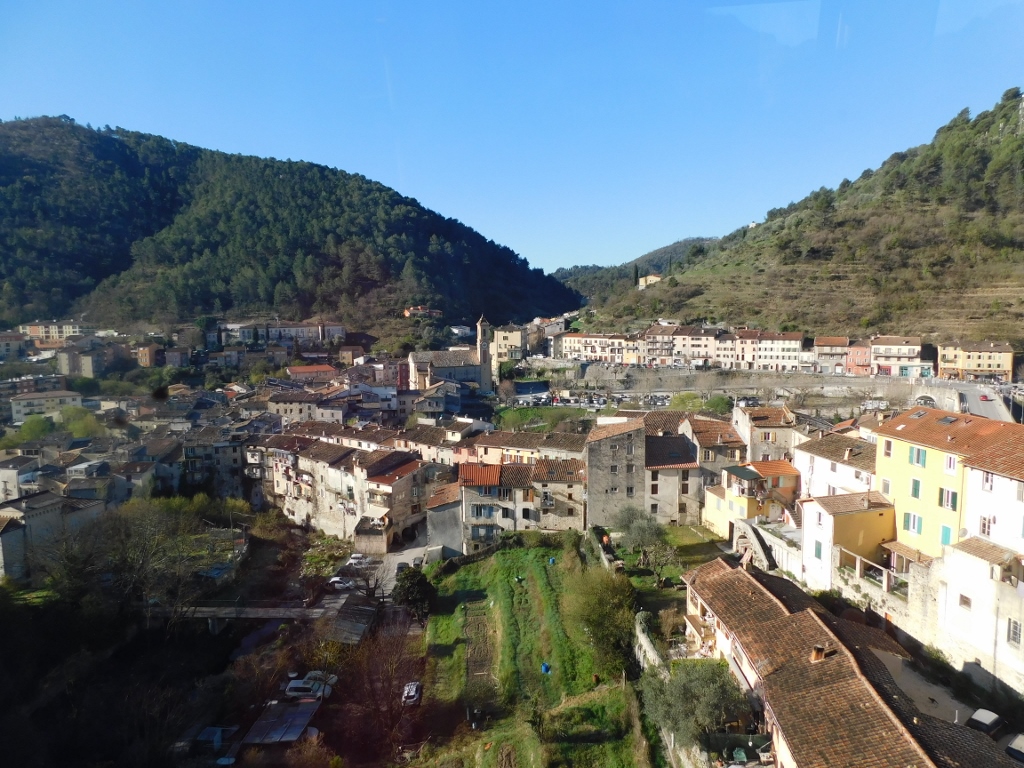 On the way from Nice to Tende
On the way from Nice to Tende
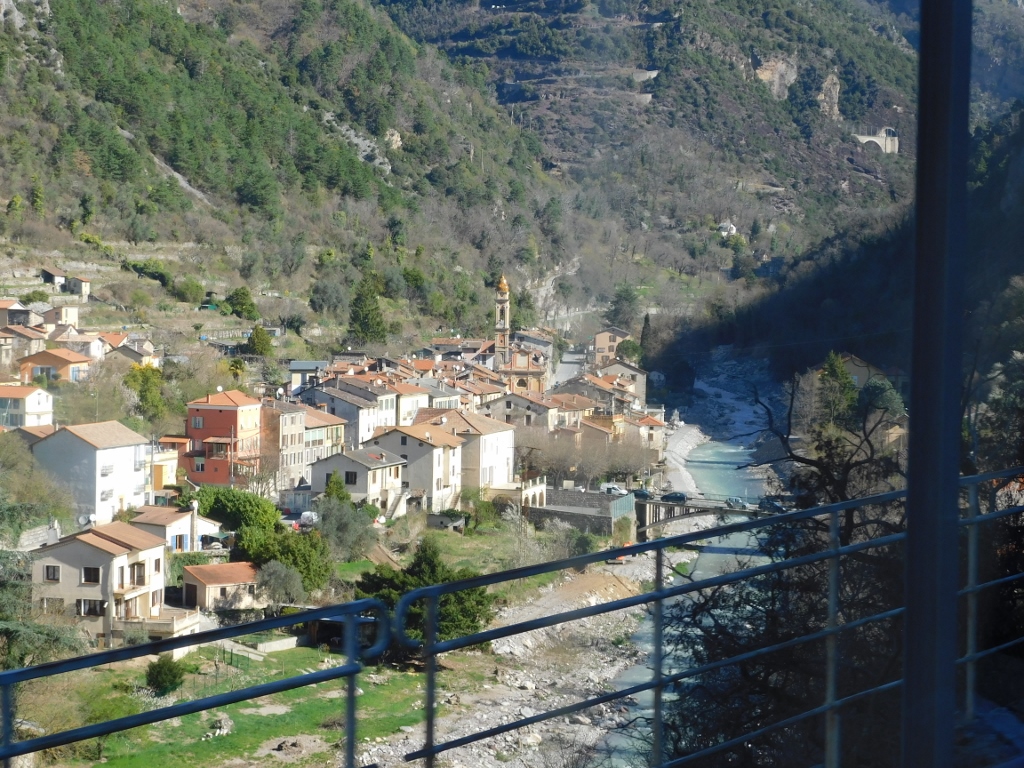 On the way from Nice to Tende
On the way from Nice to Tende
The fact is also that the construction of this railway line from Nice to the town Cuneo in Italy, with Tende being a place some 15 km away from the border with Italy, which started in 1883, required exceptional engineering and technological skilfulness taking into consideration that there are some hundred bridges and viaducts along the railway, as well as almost the same number of tunnels and retaining walls. There are even some spiral tunnels that enable the train to gain in altitude while moving through the mountain itself. Because of all of this, this railway line is considered as one of the most impressive in the world. The distance between Nice and Tende is around 80 km, while the altitude difference is around 820 m.
Namely, the railway line runs mostly through the Alpes-Maritimes department and because of this demanding terrain the construction of the railway, as well as the later-date asphalt roads, constituted a very demanding task at the turn of the centuries.
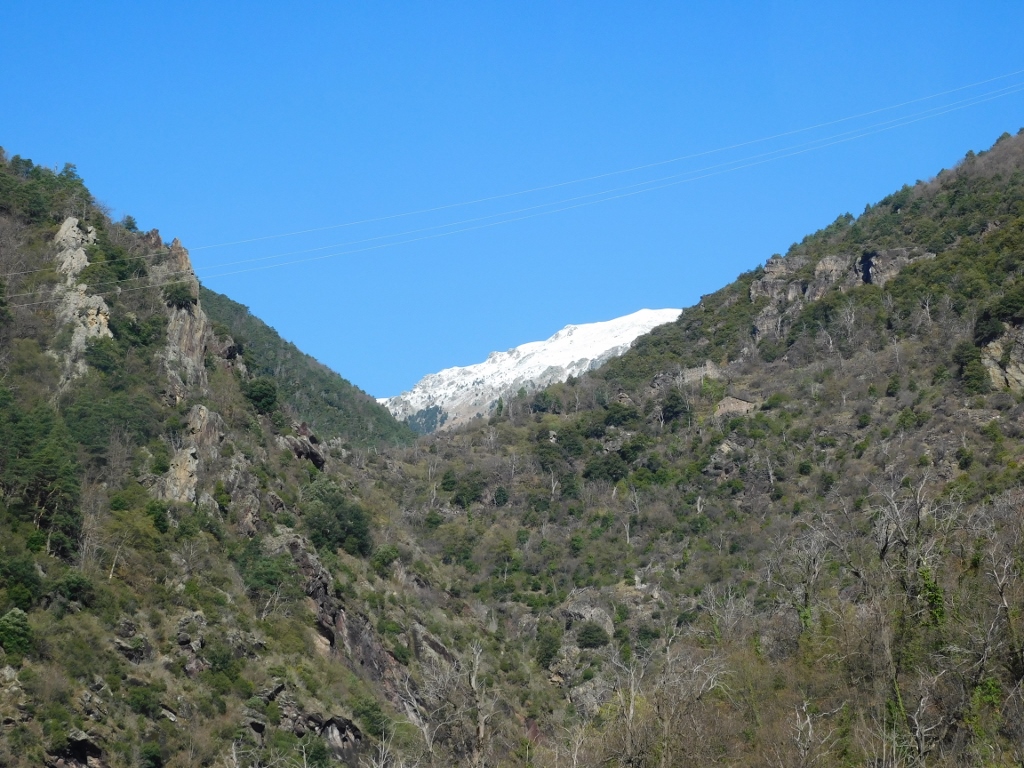 Alpes-Maritimes at the beginning of April
Alpes-Maritimes at the beginning of April
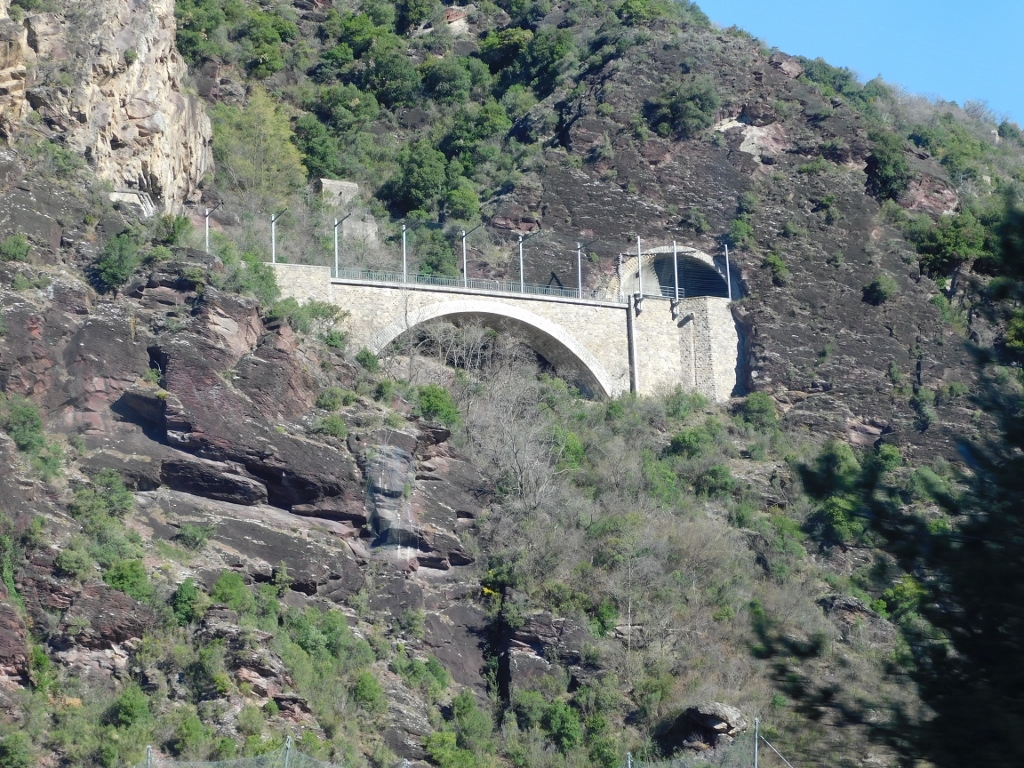 One of the numerous viaducts that can be seen from the train; this one is intended for road traffic
One of the numerous viaducts that can be seen from the train; this one is intended for road traffic
The railway line was opened in 1928 and it runs through unquestionably beautiful landscapes. Although I was not beside myself with delight, I certainly enjoyed and I can wholeheartedly recommend this trip. Admittedly, it was often difficult to take photos because of a sudden appearance of a landscape, or a sudden entering into a tunnel, or the sunlight that made reflection on the train windows, or smudged windows, ... But, every now and then I managed to prevail over such challenges.
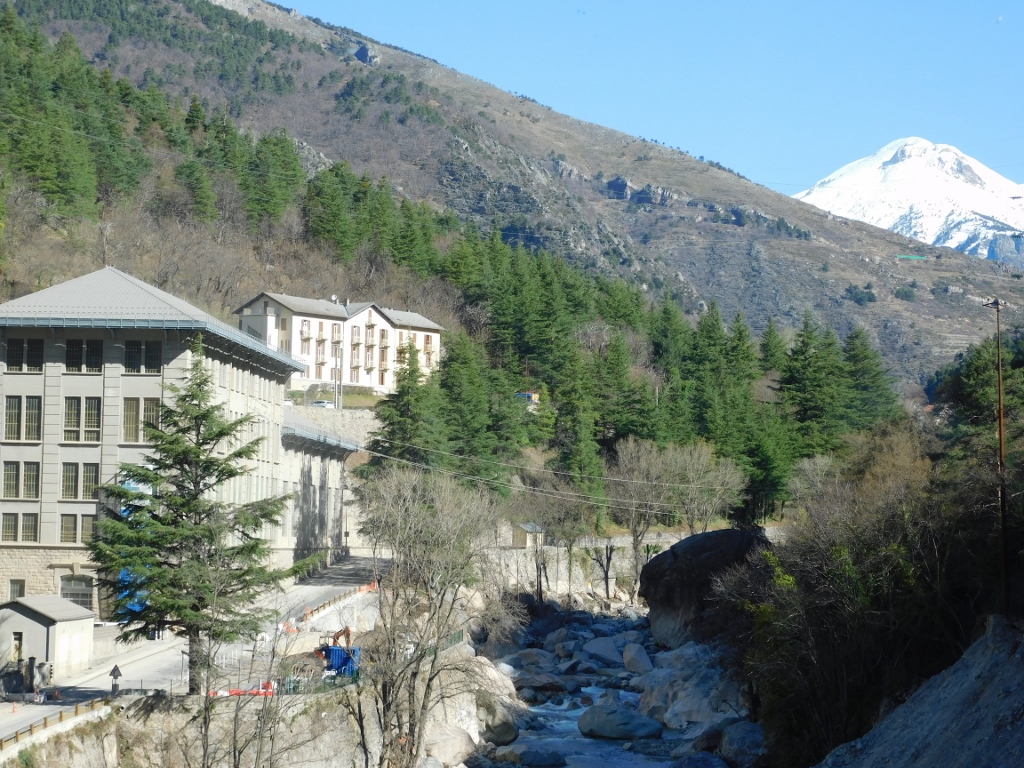 On the way from Nice to Tende
On the way from Nice to Tende
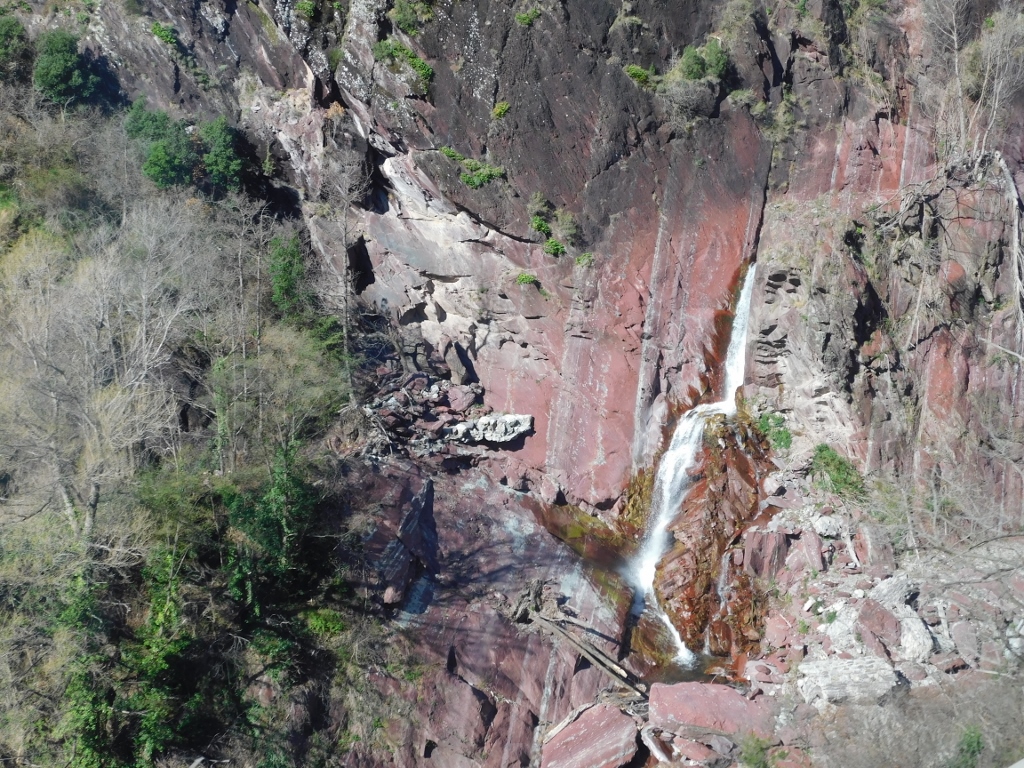 A waterfall coming out of a crack in a cliff
A waterfall coming out of a crack in a cliff
After a couple of hours, I saw Tende. The first photo was taken before a tunnel and the second one after it. In-between it was pitch black. That’s what it is in the Alps.
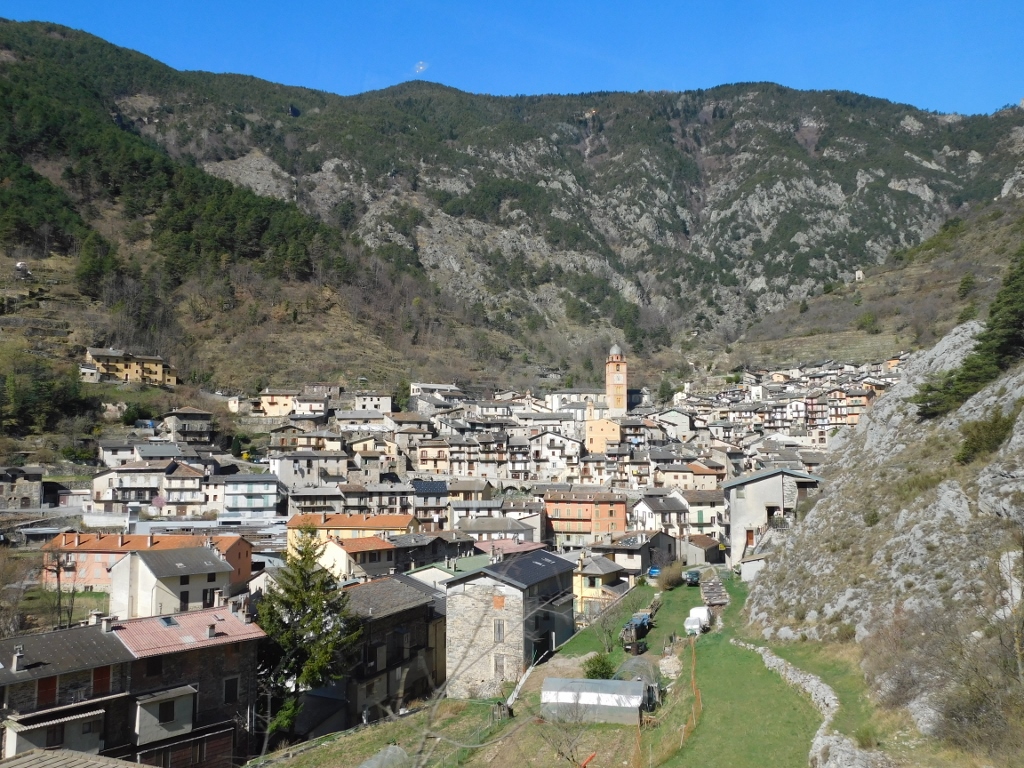 Tende
Tende
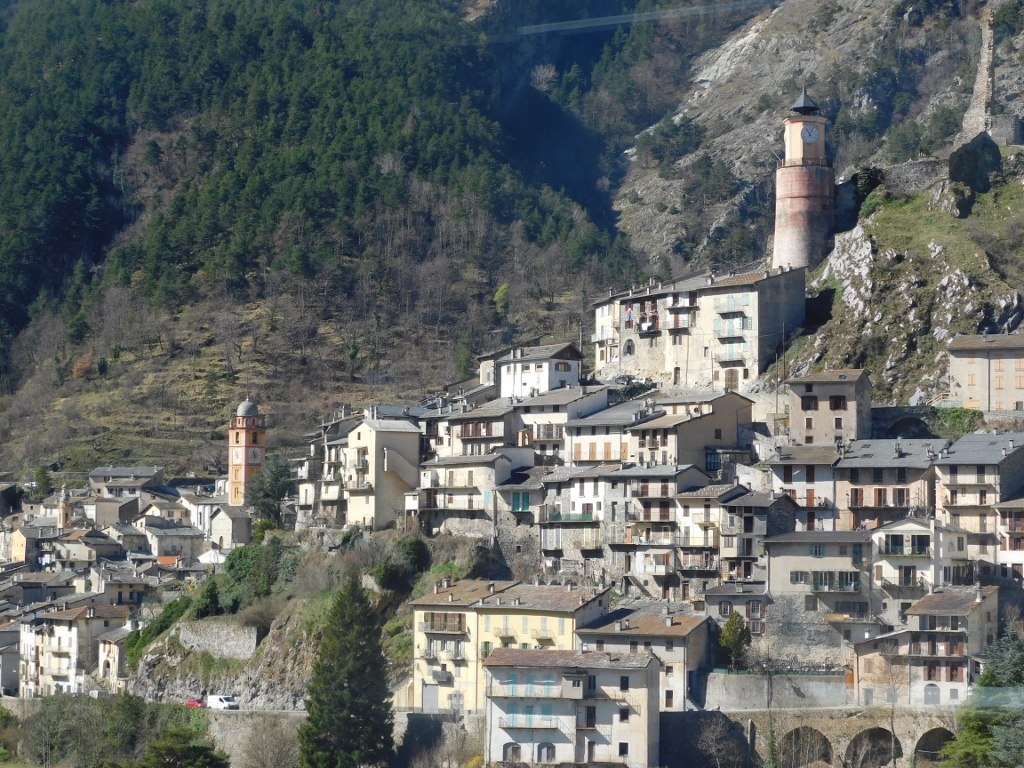 Tende
Tende
Tende is a small place within the Mercantour National Park. The park is renowned for its numerous walking trails through nature and it also incorporates a number of small, picturesque villages, with all of this located in a high mountain region. Around Tende there are over 20 summits with altitude of over 2000 m. Thus, already from the train station in Tende I could see two mountains the summits of which were covered in snow.
 View from the train station in Tende
View from the train station in Tende
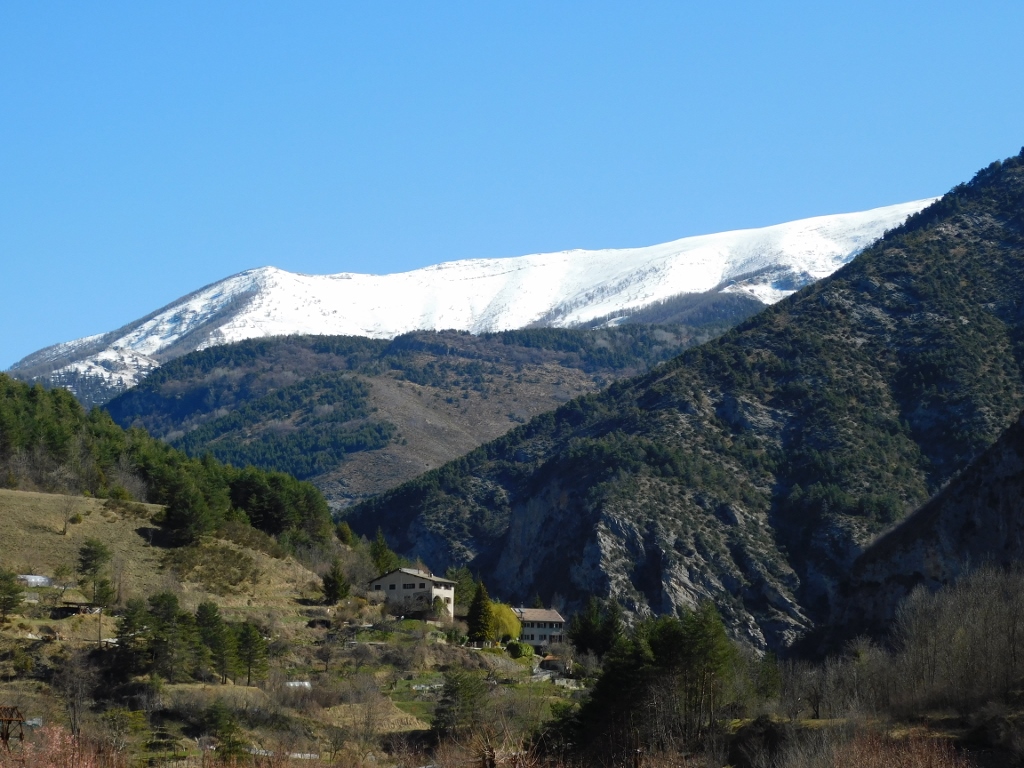 One of the mountains covered in snow
One of the mountains covered in snow
After taking these photos, I walked to the tourist office where I got a couple of maps and I also inquired about a possible short hiking trail nearby, since I had a few hours available and so I thought it would be nice to walk through nature a little. Still, all this walking had to wait because I first sat in a café in the main street in order to wake up some more with a nice coffee. Only after I had done that I was ready for the sightseeing of the village.
Some prehistoric stone engravings have been found in the surroundings of Tende, but it still remains unclear when the first settlement was established. During the Middle Ages, Tende was passed from the hands of one ruler to those of another several times and by the nature of things it all came down to the French and the Italians. Probably the main reason for this is the fact that Tende was located on an important salt trading route between France and Italy. In any case, from 1861 till 1947, Tende belonged to Italy, but in a referendum the residents decided that after WWII they wanted the village to belong to France.
One of the most striking landmarks of Tende that I also saw when arriving by train is the main tower that represents the residue of a castle that used to belong to the Lascaris Counts. The castle was built in the 14th century and in 1692 it was destroyed by the troupes of Louis XIV. The only part of the castle that has survived is this circular tower that had a clock added to it in the 19th century, so nowadays it serves as a clock-tower.
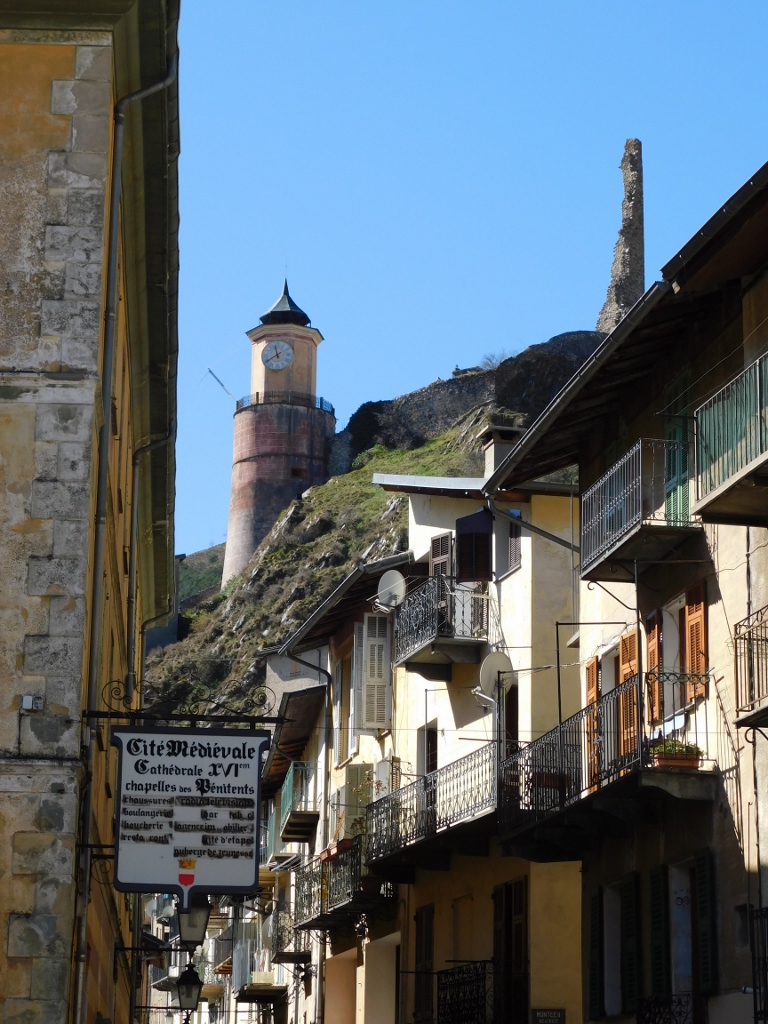 Tende
Tende
The main route for the sightseeing of the old part of Tende is a street, Rue de France, that starts from the local Republic Square (Place de la Republique).
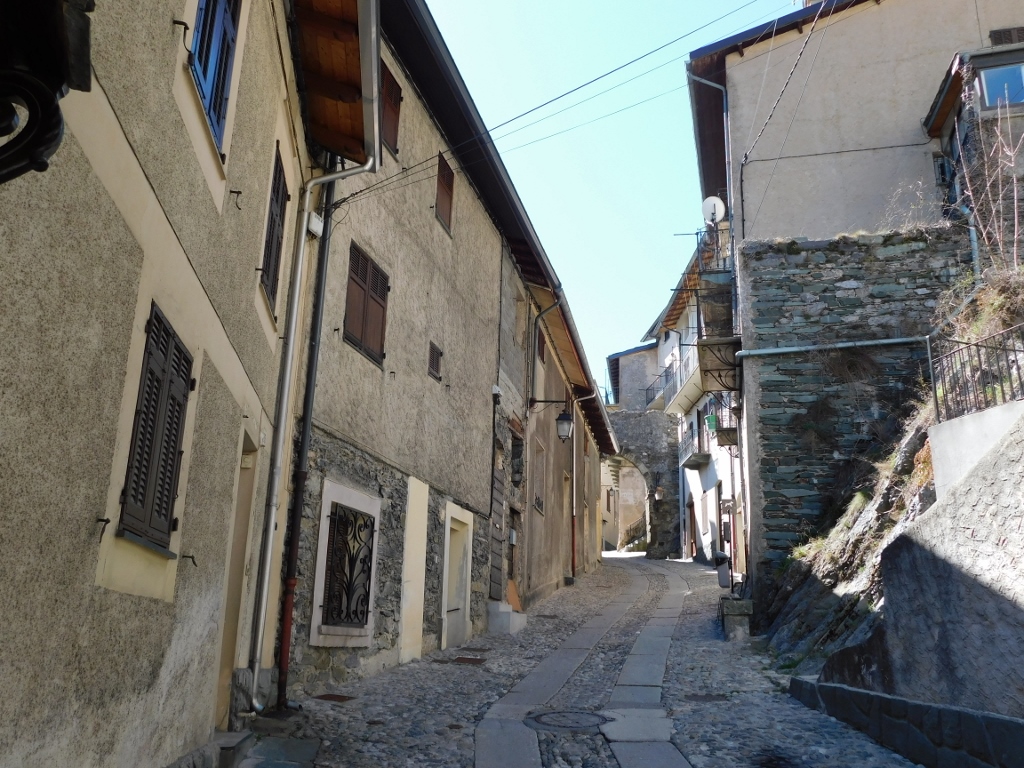 Tende, Rue de France
Tende, Rue de France
The whole old part of the village is located on a rocky slope on the top of which there used to be this castle with the tower. From time to time this entails some seriously steep sections. I think it is perfectly clear why I had no intention of climbing up to the tower. I could see it quite nicely from the lower sections, too.
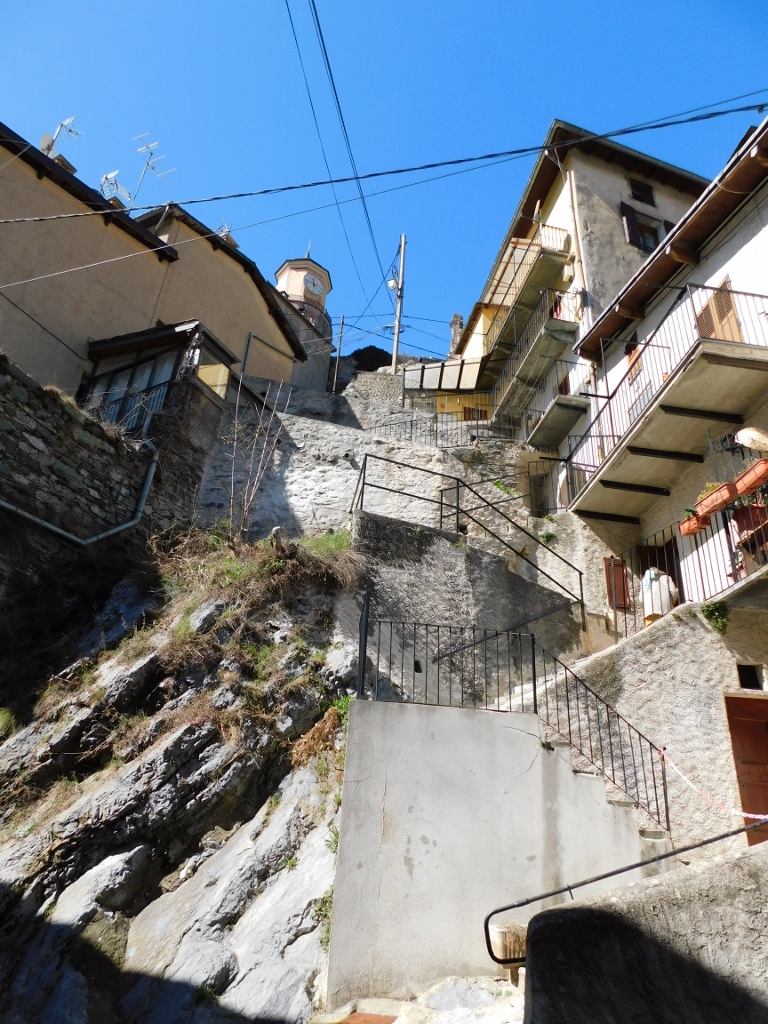 Tende, the top of the clock-tower can be seen on the top, to the left
Tende, the top of the clock-tower can be seen on the top, to the left
Proceeding further along the much less steep Rue de France, I reached Italy Gate (Porte d’Italie) and the Chapel of the Annunciation built adjacent to the gate. The chapel contains frescoes from the 15th century, but, as it may be seen in the photo, the chapel was closed and I could not look at the frescoes.
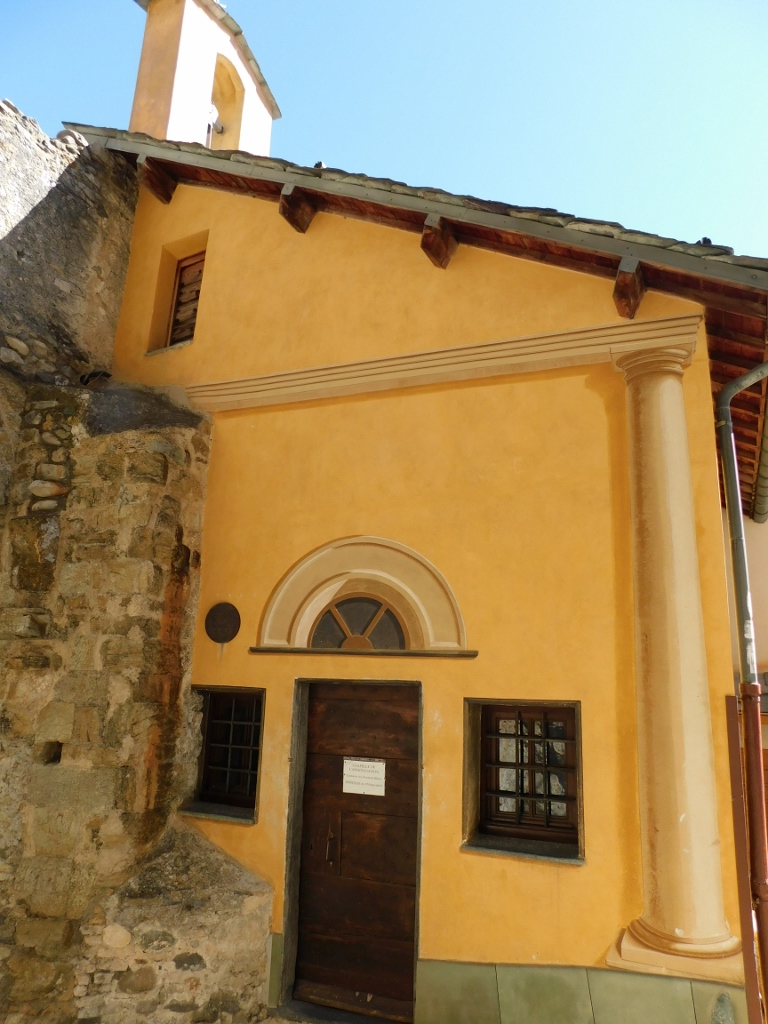 Chapel of the Annunciation
Chapel of the Annunciation
 Italy Gate is on the left-hand side, with the Chapel of the Annunciation built right next to it
Italy Gate is on the left-hand side, with the Chapel of the Annunciation built right next to it
I really loved the walk along this street that in the past served as the main access route leading to the castle since I found the sights from the village of Tende exceptionally picturesque.
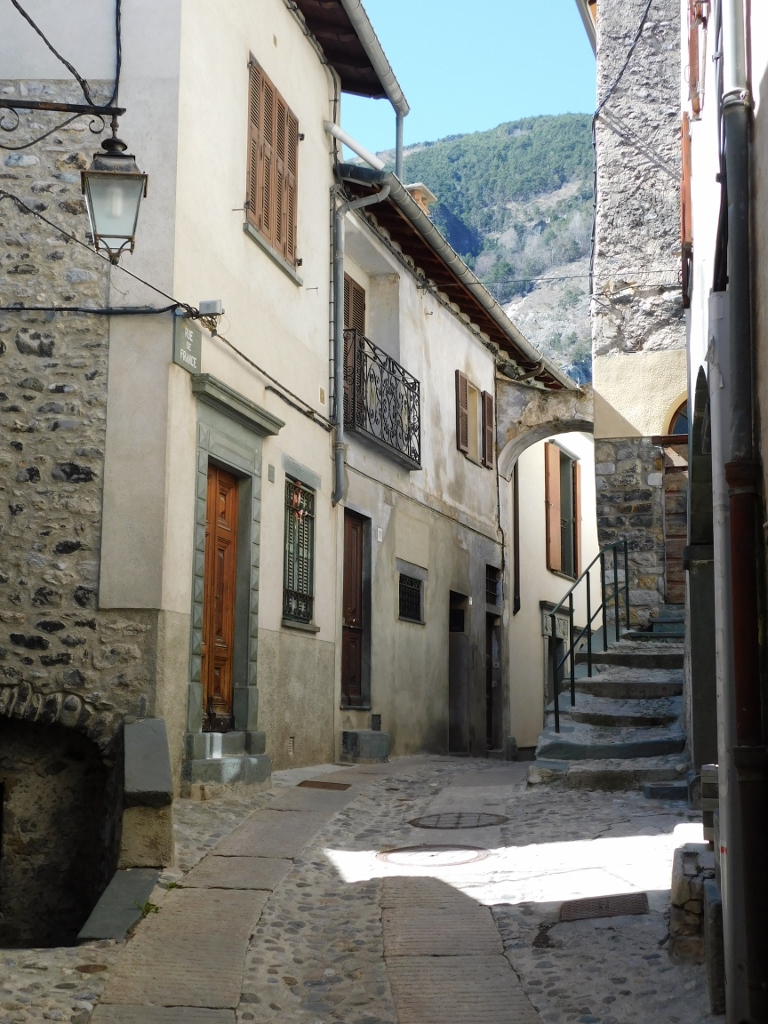 Tende, a detail from Rue de France
Tende, a detail from Rue de France
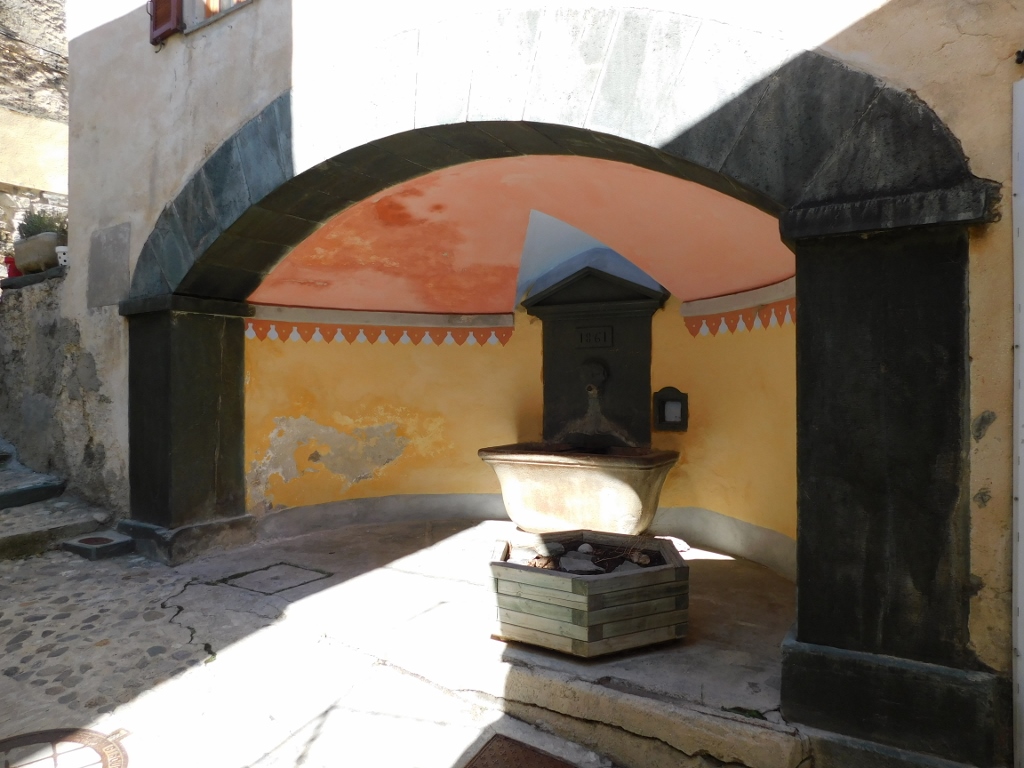 Tende, a detail from Rue de France – I’m sure that in the past fresh water used to run here
Tende, a detail from Rue de France – I’m sure that in the past fresh water used to run here
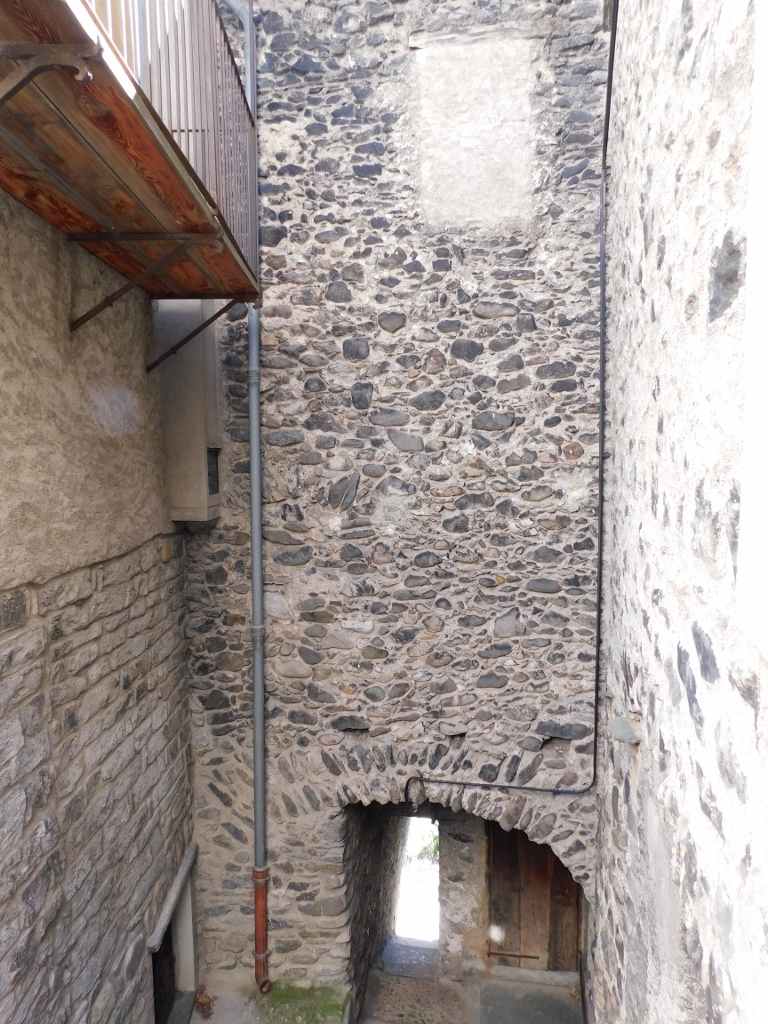 Tende, a detail from Rue de France
Tende, a detail from Rue de France
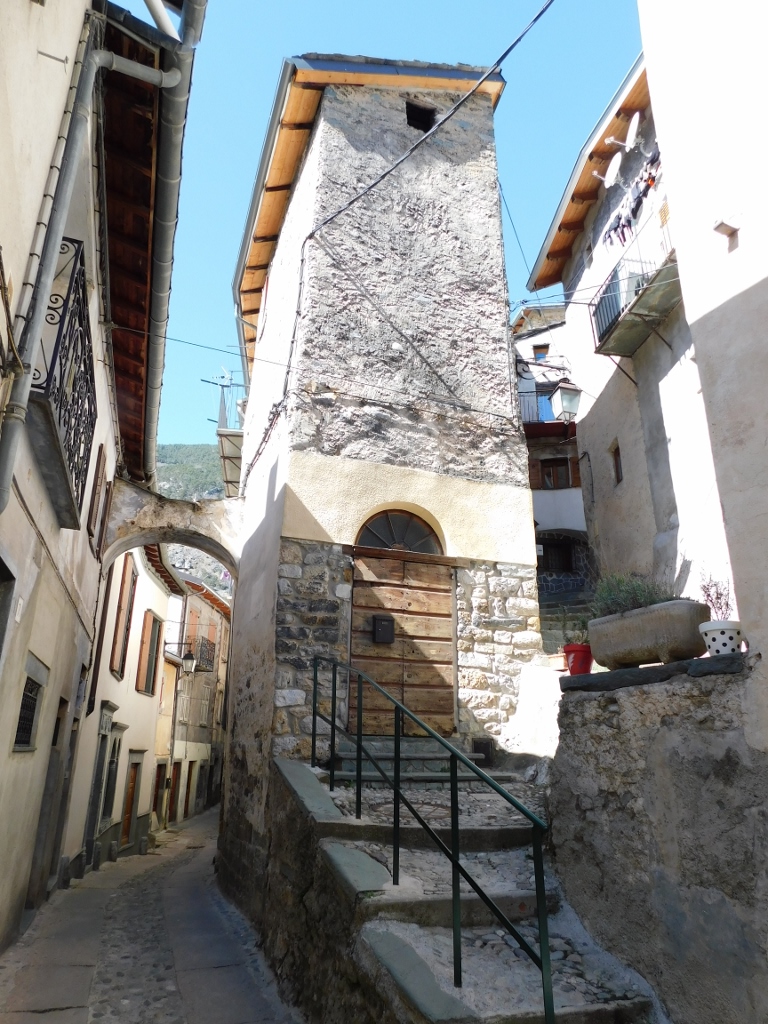 Tende, a detail from Rue de France
Tende, a detail from Rue de France
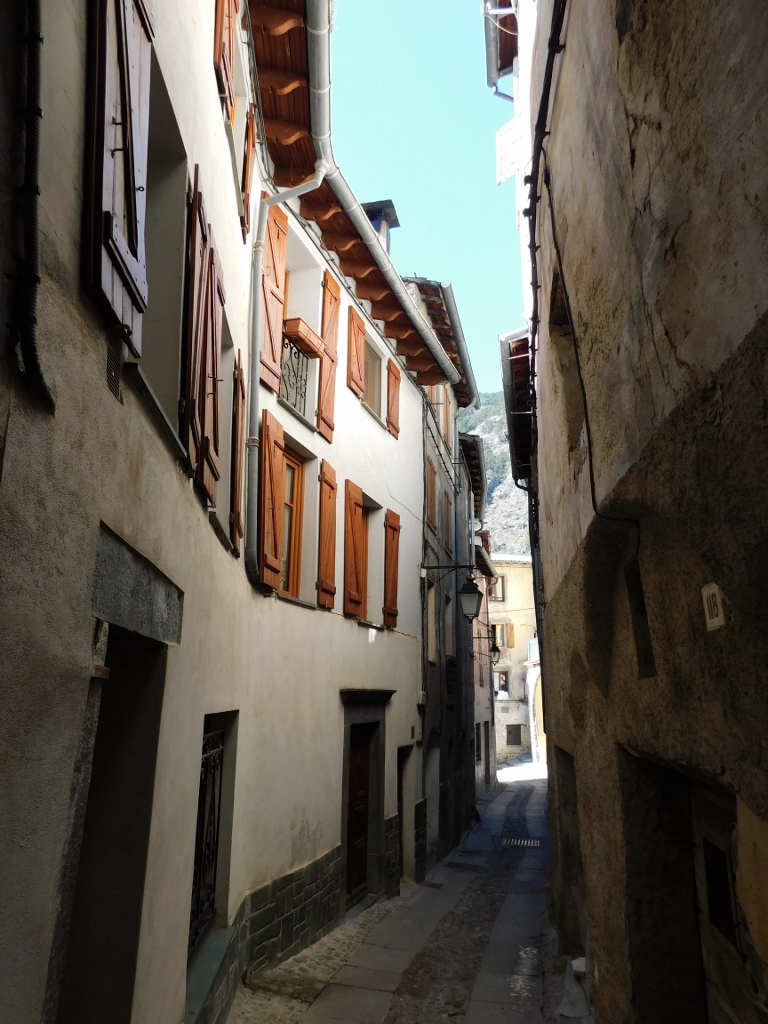 Tende, a detail from Rue de France
Tende, a detail from Rue de France
Then I got to an extension where right beside the street there is a 1870 fountain built under an arch, but no water is running there now, while this clearing actually constitutes a small square called Place du Traou.
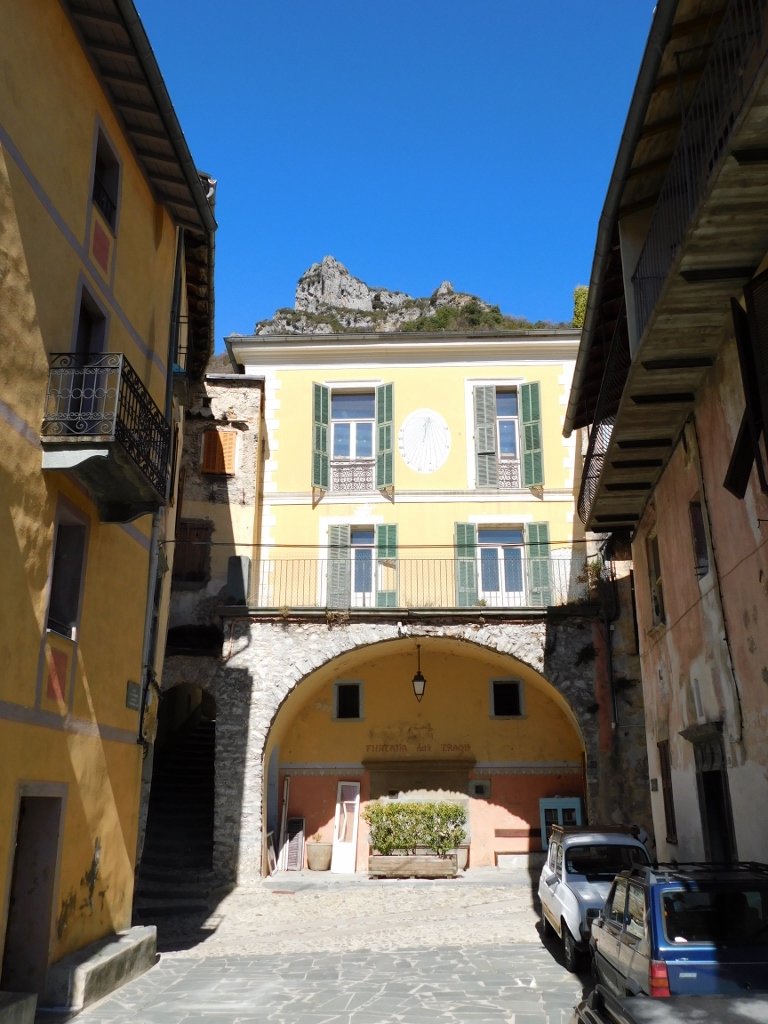 Square and the fountain du Traou
Square and the fountain du Traou
This square was used by the Counts of Tende in order to dispense justice within the court they organised here. Nowadays, this square is very interesting since it provides a very fine viewpoint.
 Tende, view from the Place du Traou
Tende, view from the Place du Traou
Among other things, the visitor can also see the Collegiate Church of Our Lady of the Assumption (Collégiale Notre-Dame-de-l’Assomption) that I went to a little later.
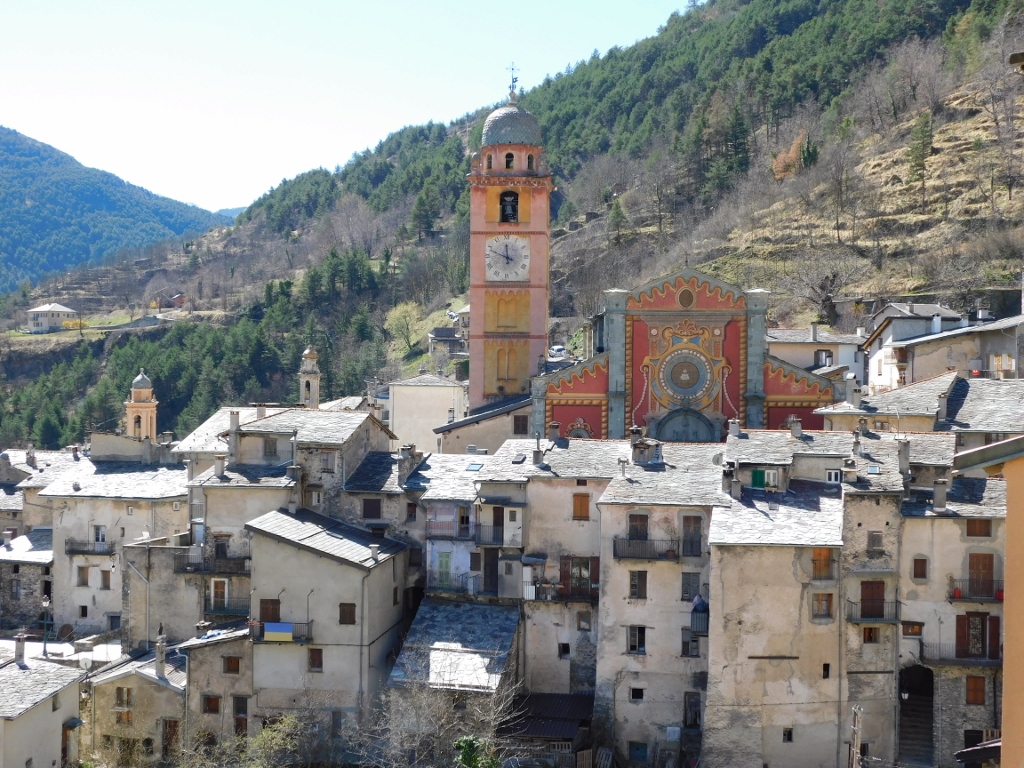 Collegiate Church of Our Lady of the Assumption
Collegiate Church of Our Lady of the Assumption
What I found fascinating here is perhaps a completely trivial thing and these were the roofs of the houses made of pieces of hewn stone that now dazzled in the sun.
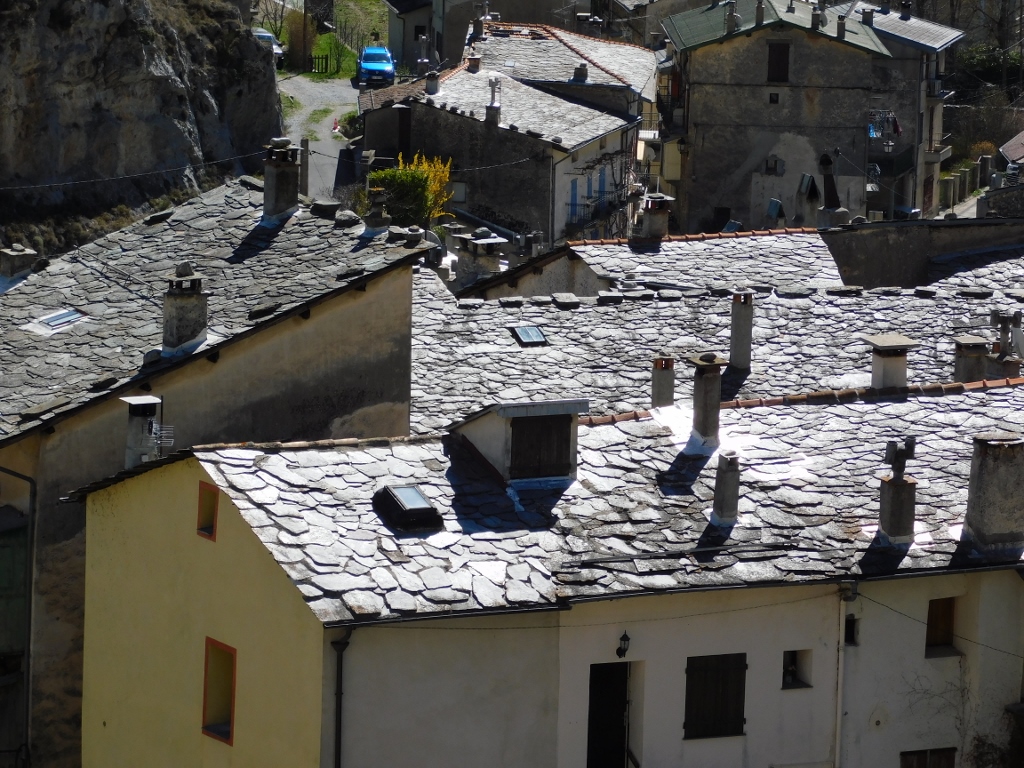 Roofs of the houses in Tende
Roofs of the houses in Tende
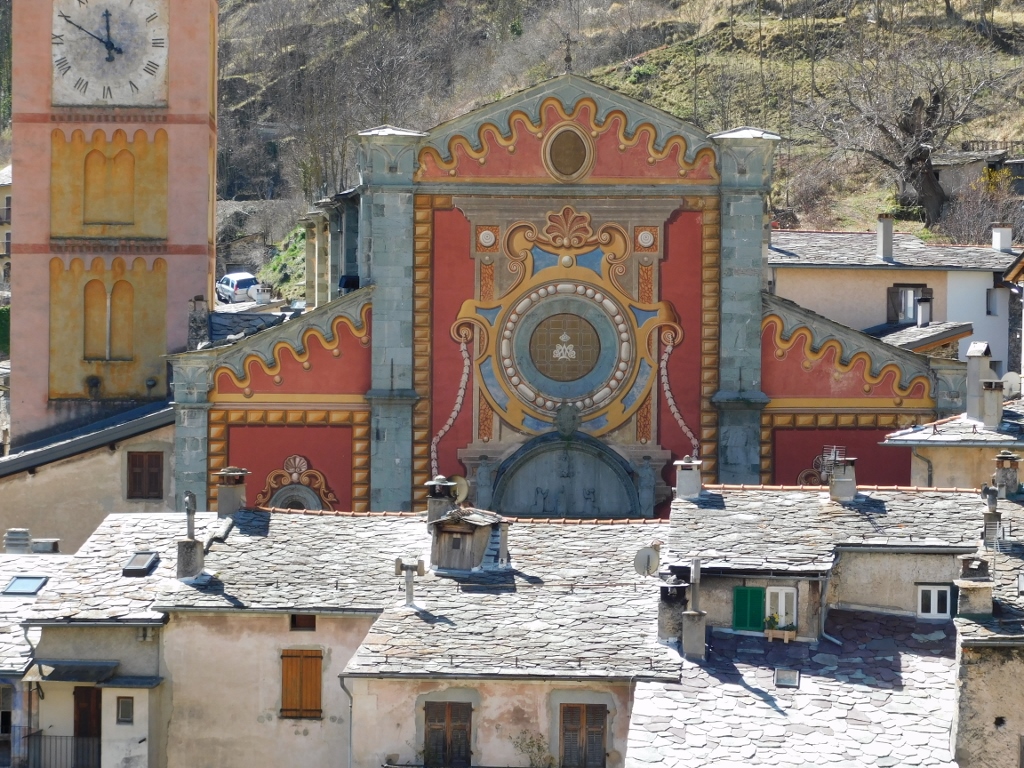 Roofs of the houses in Tende
Roofs of the houses in Tende
Walking on along the main street, I came to yet another crossroad and completely fascinating elements of the “medieval” architecture and town-planning. It was clear that only the bases were medieval and that the construction was of a more recent date, but this did not diminish my delight with different details that I noticed along my way.
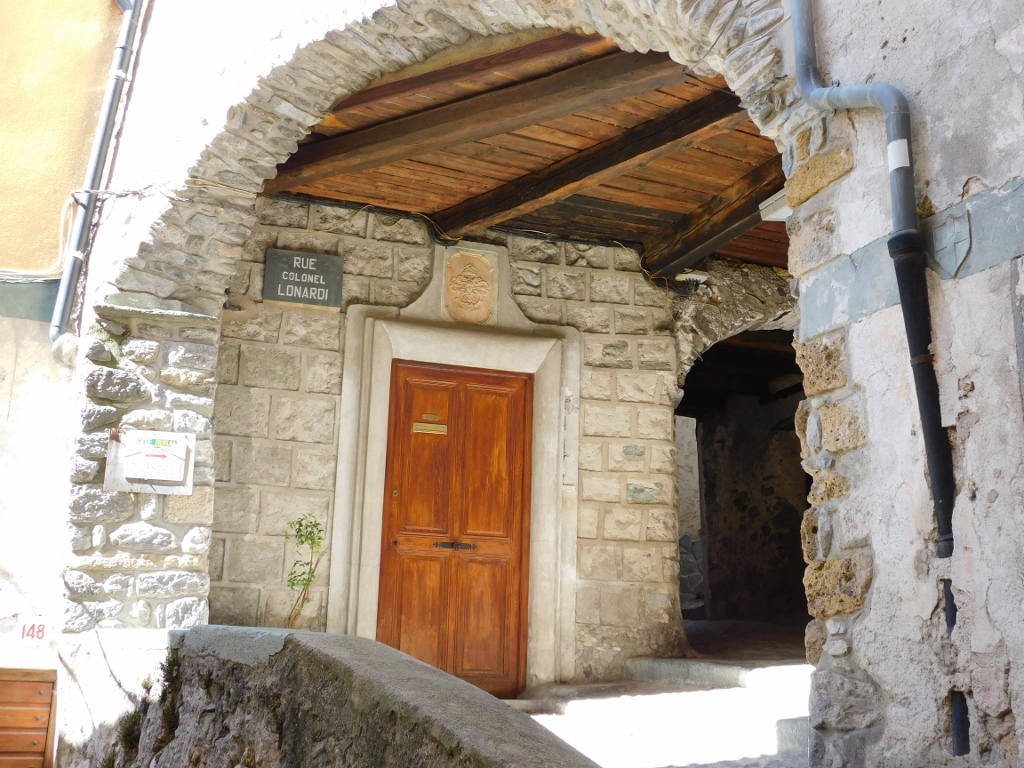 Tende, a detail
Tende, a detail
Then I also reached a square that was marked on the map I had obtained at the tourist office as Place du Ponte, while on the spot there was a sign saying Place de la Section TB. Anyway, there used to be a market here, while the square and some of the surrounding houses were built over a mountain stream.
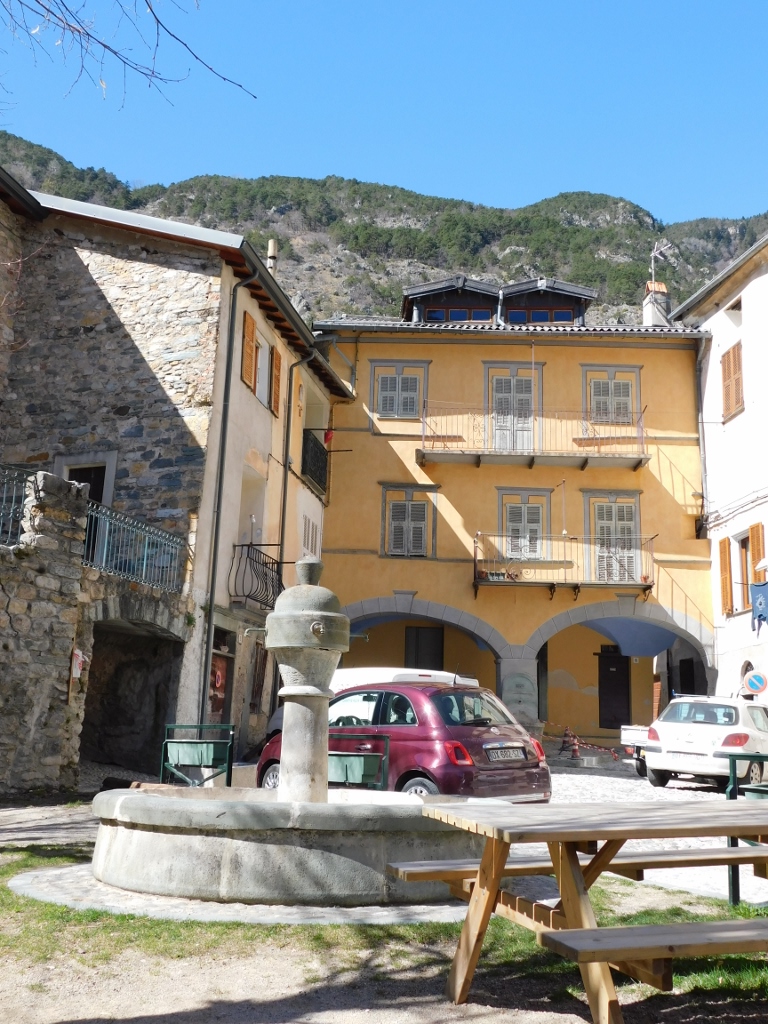 Place du Ponte
Place du Ponte
On the opposite side of the street in relation to the square, there is again a fine extension from which there is a beautiful view at Tende and the surroundings.
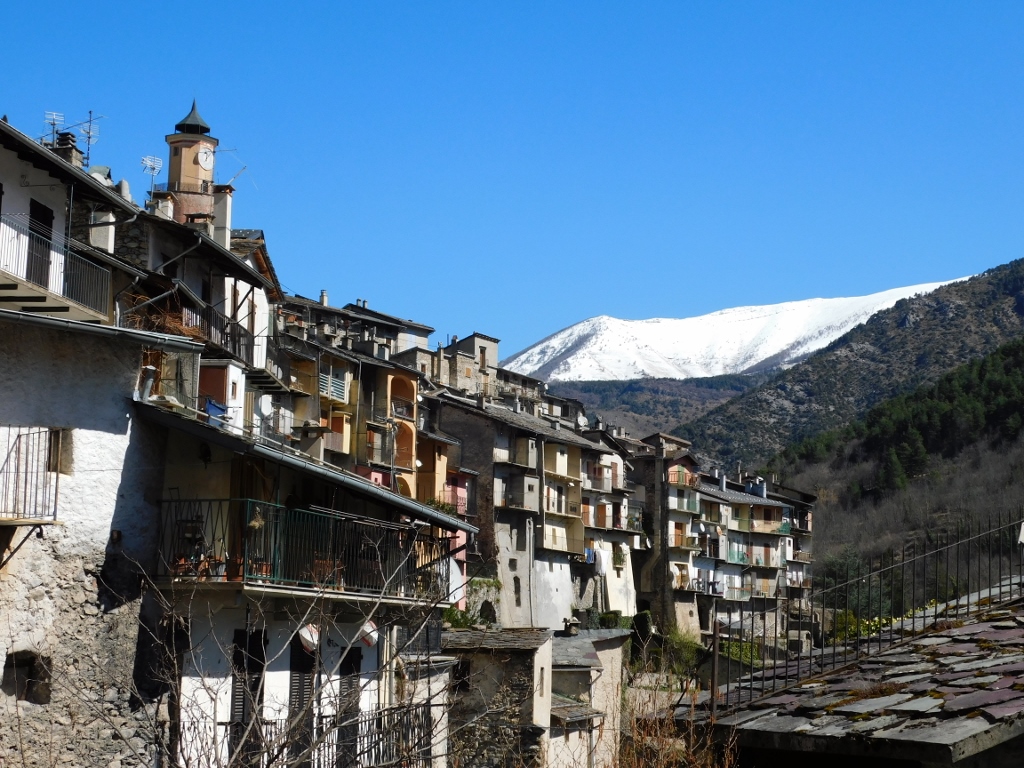 Tende, a detail
Tende, a detail
The old parts of Tende are characterised by narrow streets, with some of them being even narrower than the average ones.
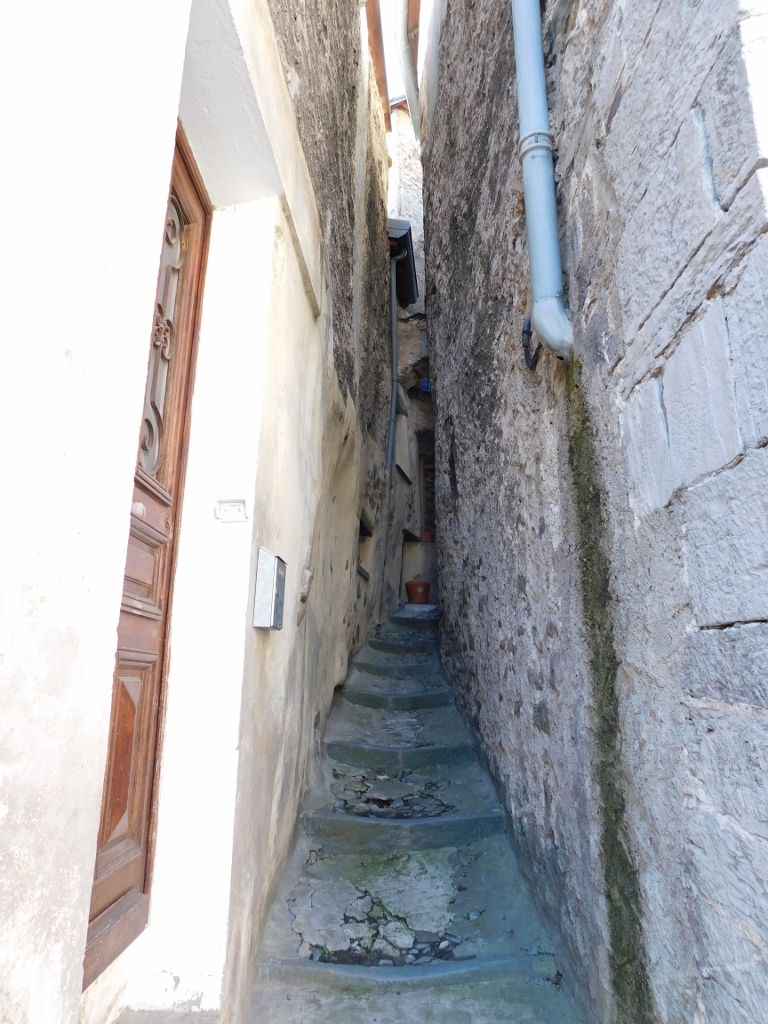 Tende, a detail
Tende, a detail
Soon I reached a narrow space in front of the Collegiate Church of Our Lady of the Assumption that used to have the status of a cathedral, while also losing the status of a collegiate church in the meantime, although this latter name has persevered.
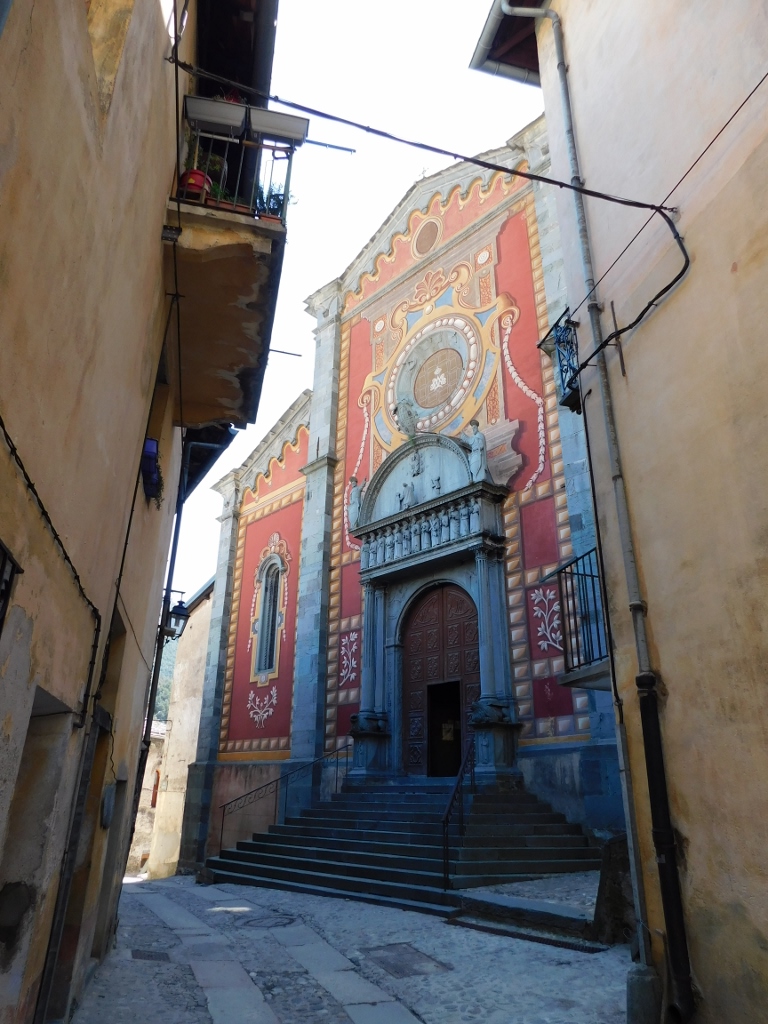 Front facade of the Collegiate Church of Our Lady of the Assumption
Front facade of the Collegiate Church of Our Lady of the Assumption
The construction of the church started around the middle of the 15th century on the orders of Count Honoré Lascaris I and it is interesting that the bell-tower was finished before the church – in 1462. The picturesque front facade was created in the 19th century, while the portal made of green stone was made in 1562. Since the church was open, I went in and walked around a little.
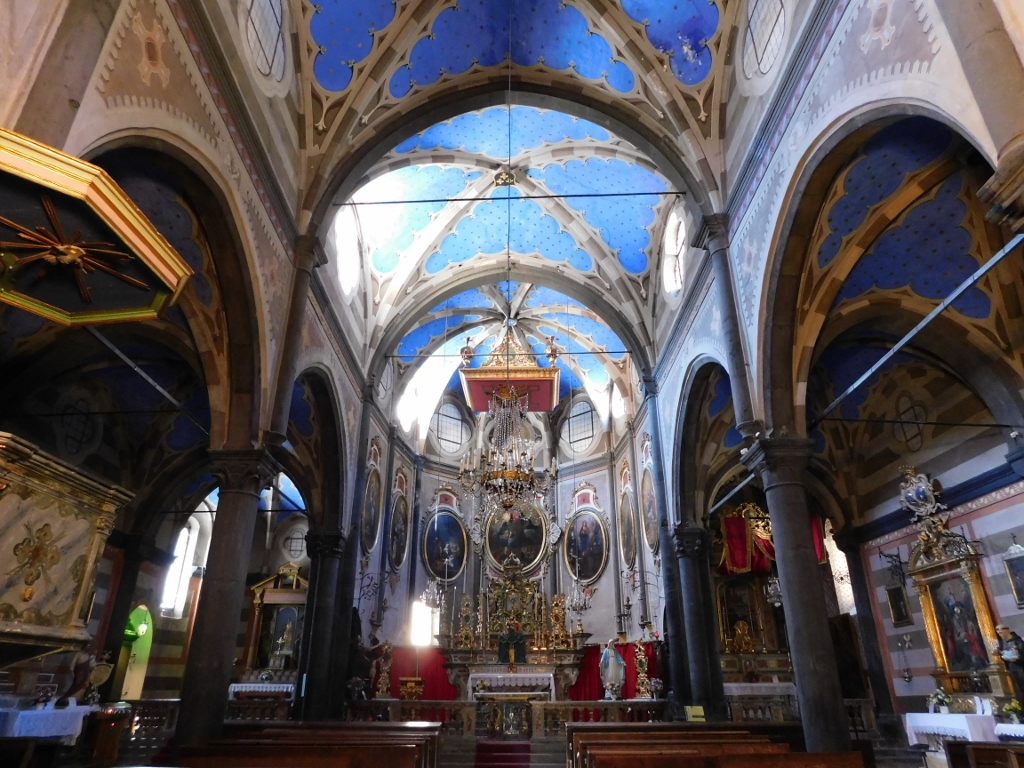 Collegiate Church of Our Lady of the Assumption, a detail
Collegiate Church of Our Lady of the Assumption, a detail
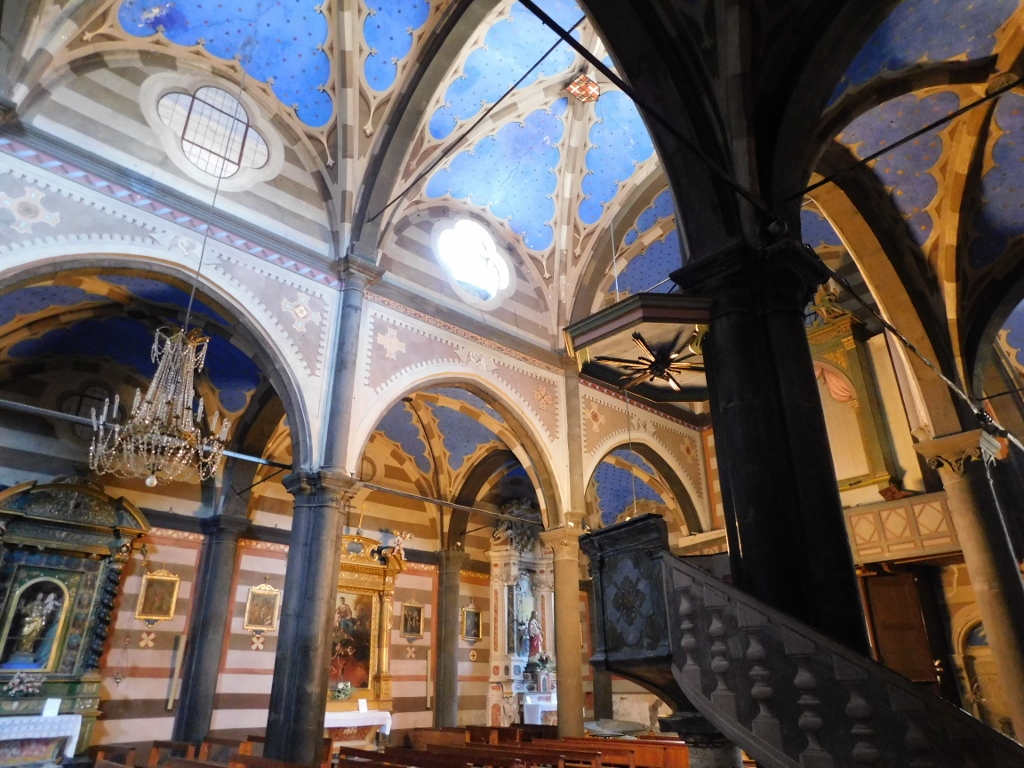 Collegiate Church of Our Lady of the Assumption, a detail
Collegiate Church of Our Lady of the Assumption, a detail
Once I’d finished with the visit to the church, I went out and proceeded to a square that is located by the side of the church. From there I could have a nice view at the church tower which on the top of the square base has an octagonal drum and then a dome on top of the latter.
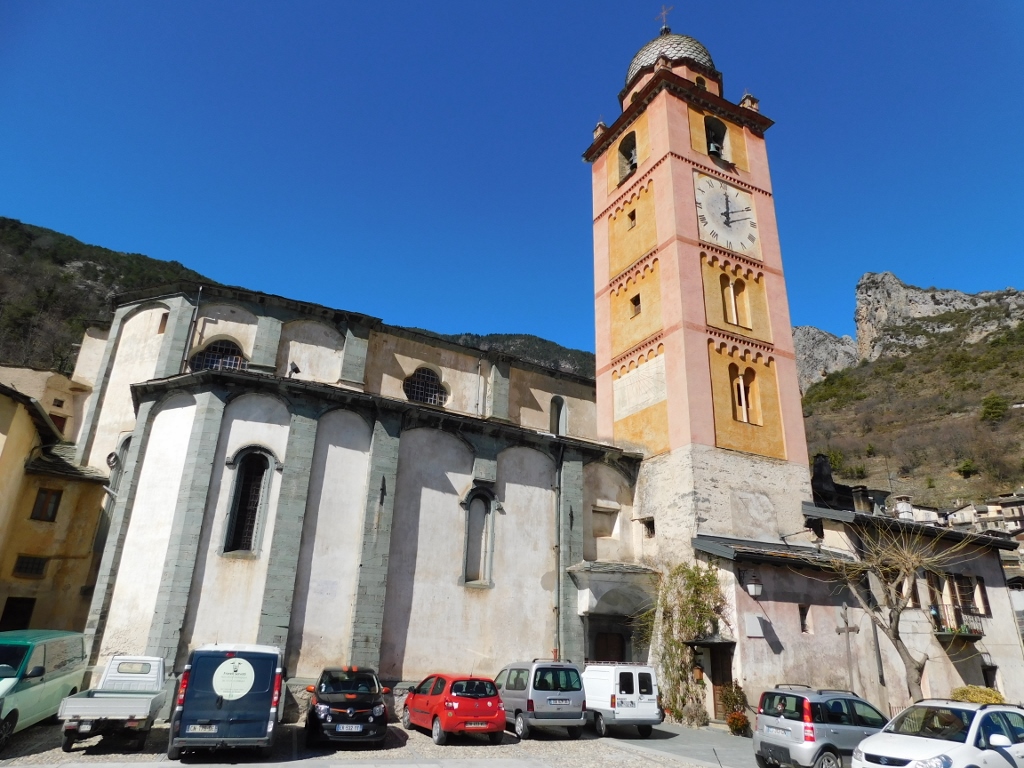 Collegiate Church of Our Lady of the Assumption, a detail
Collegiate Church of Our Lady of the Assumption, a detail
From that square there is also a fine view at the local cemetery constructed high up, among the remains of the former castle, as well as at the only surviving tower of that castle, some picturesque parts of Tende and the surroundings.
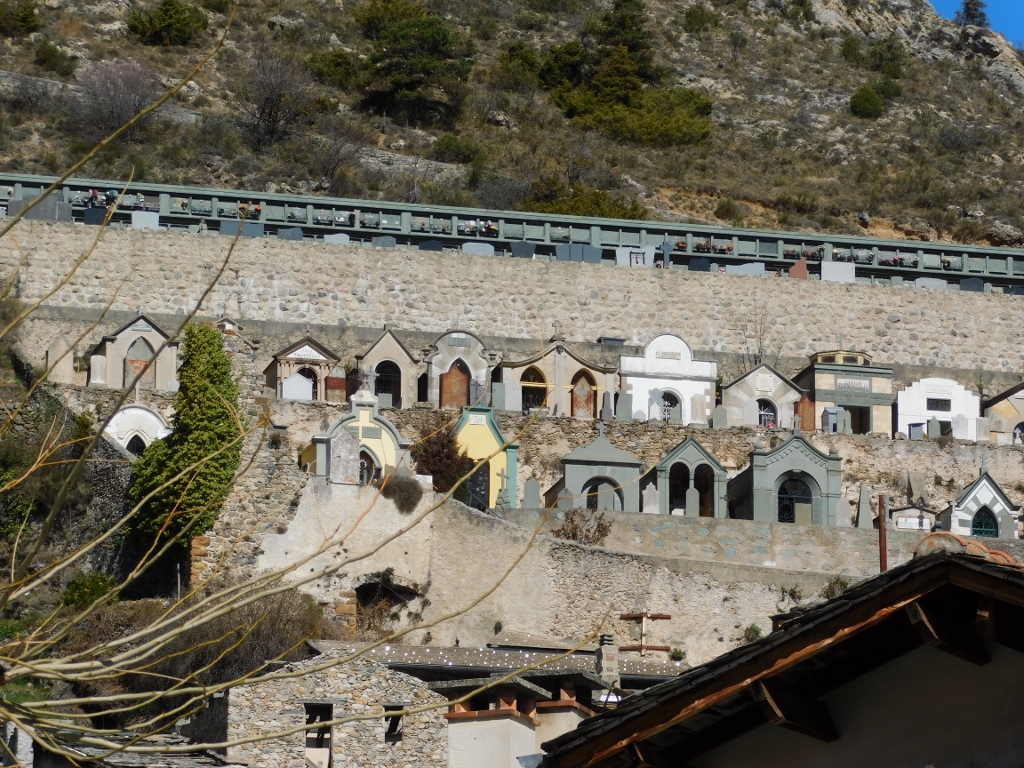 Cemetery in Tende
Cemetery in Tende
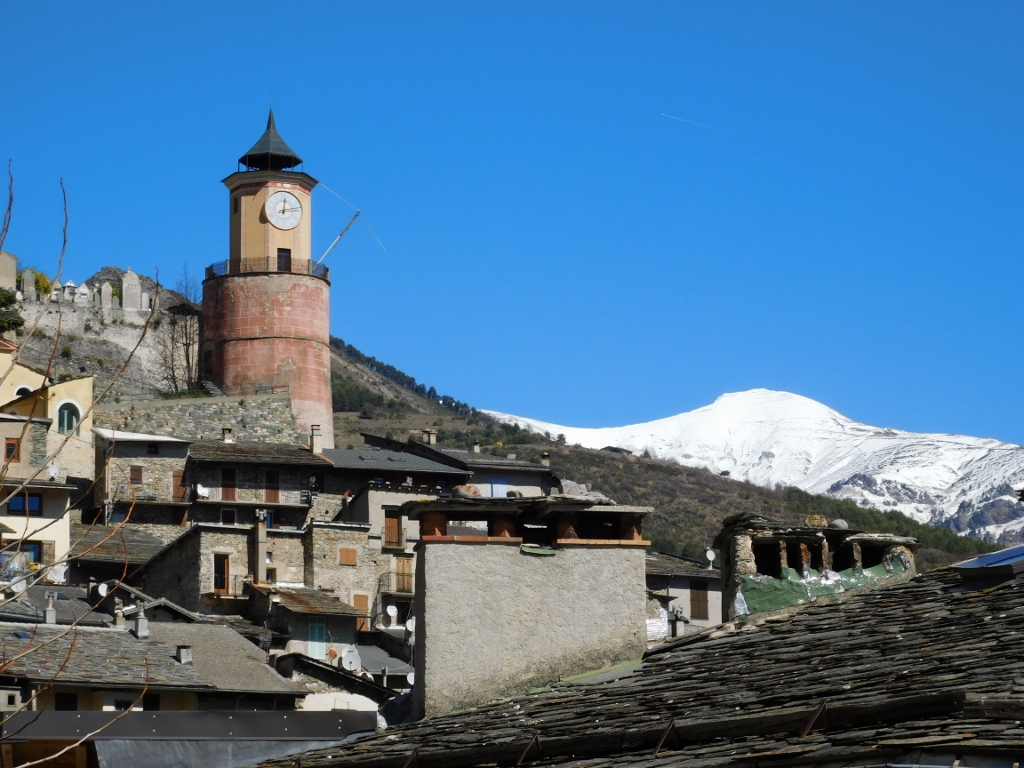 Tende, details
Tende, details
From that square it is also possible to see the upper parts of two churches that are situated in a street called Rue Cotta.
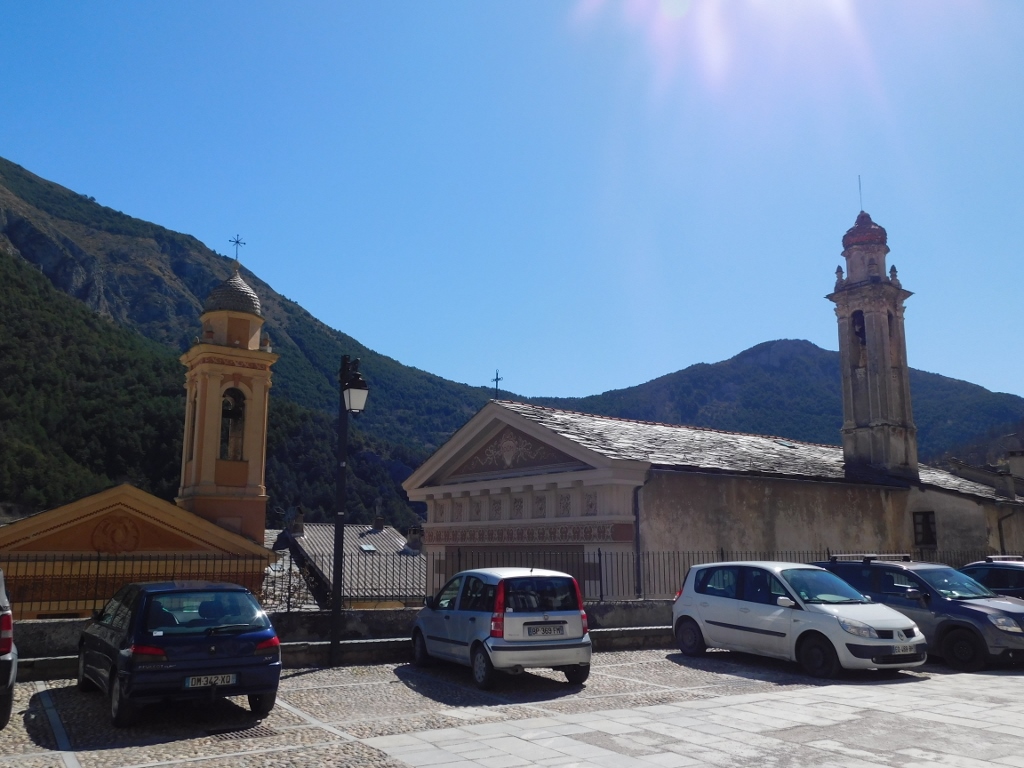 Tende, details
Tende, details
One of these two churches is the Chapel of the Annunciation, also called the Chapel of the White Penitents. The church was consecrated in 1621 and it was decorated in the 18th century, which I could not see since the chapel was closed.
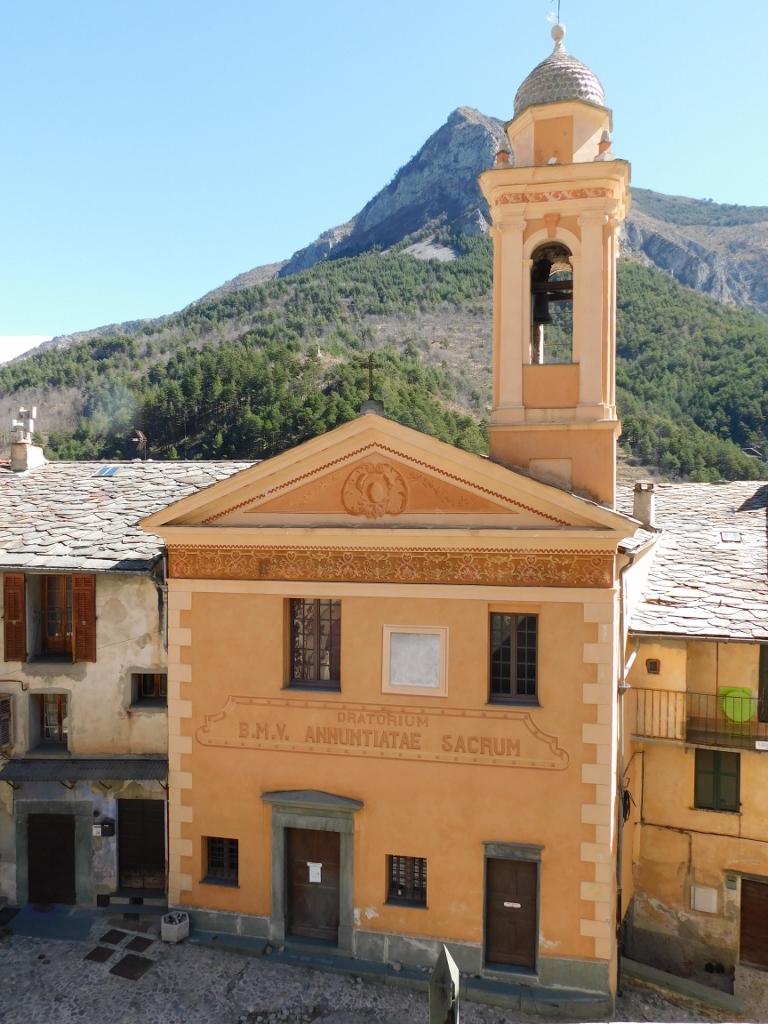 Chapel of the White Penitents
Chapel of the White Penitents
There is a small square-like area in front of the church and there is another chapel, the Chapel of the Black Penitents, dedicated to the Mercy which may be seen from its name in French: Chapelle des Penitents Noirs de la Miséricorde. This chapel with the facade that is reminiscent of an antique temple was consecrated in 1675. In the direct proximity of the chapel there is yet another fountain protected by a vault.
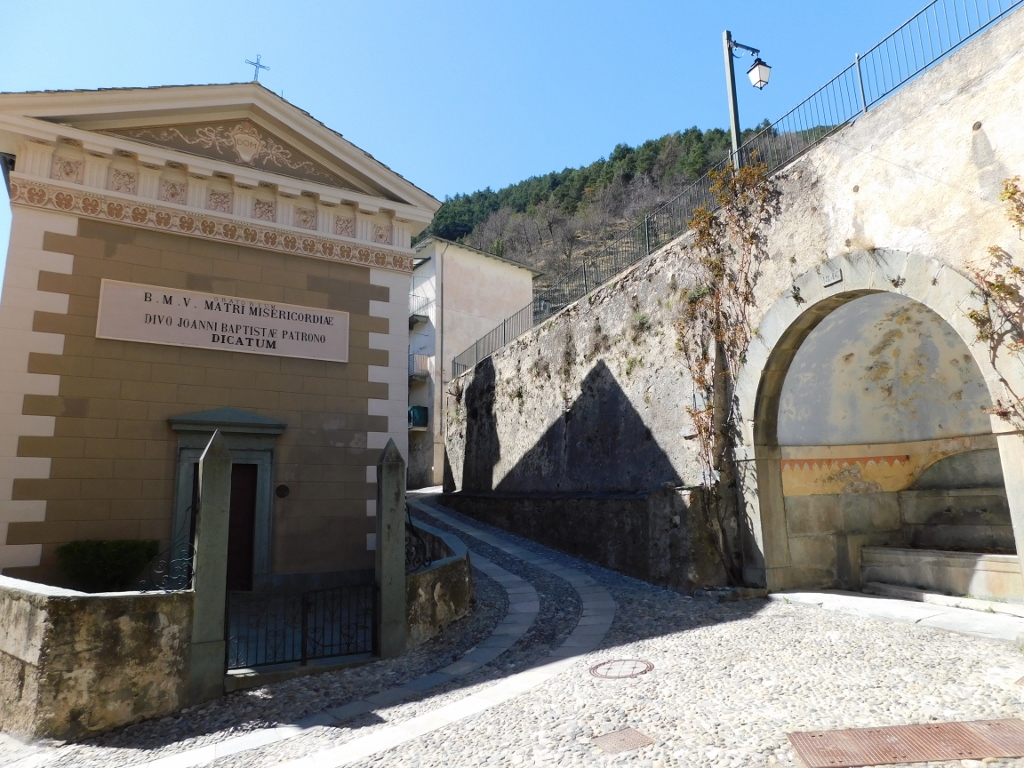 Chapel of the Black Penitents
Chapel of the Black Penitents
I could not get in here either as it was closed, but I found it very interesting that with its +/- 2000 inhabitants that according to the censuses ever since the end of the 18th century have lived here, Tende has this high a number of churches.
From the square in front of these two chapels, I also had a nice view at the tower of the Collegiate Church of Our Lady of the Assumption.
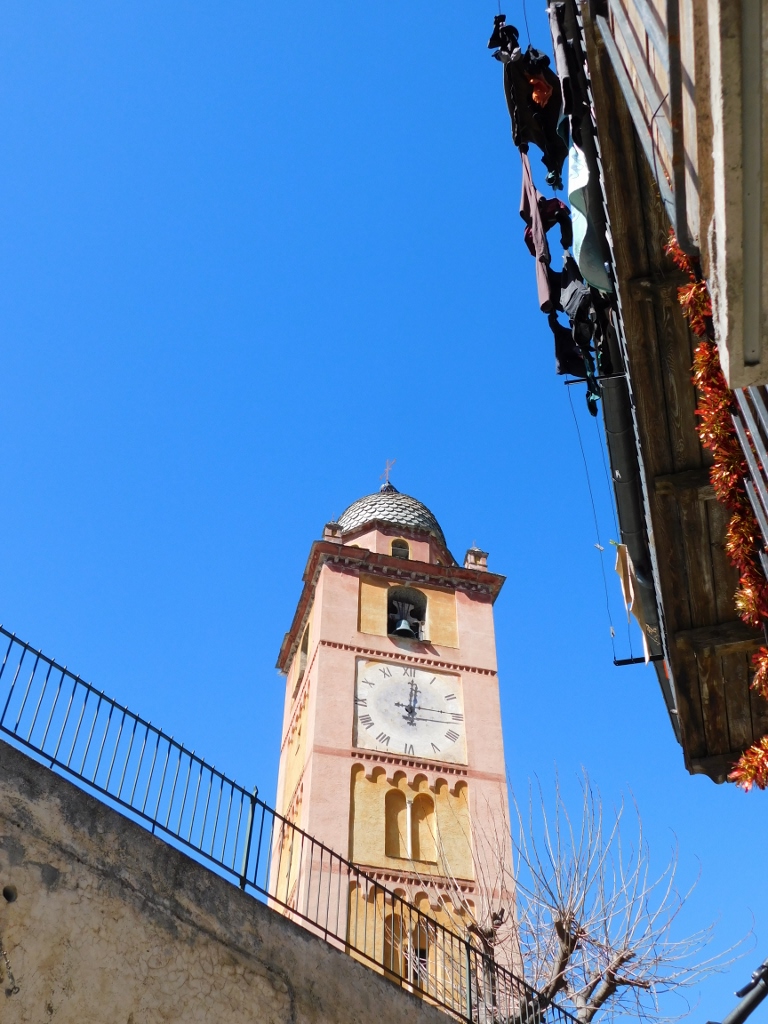 Tower of the Collegiate Church of Our Lady of the Assumption
Tower of the Collegiate Church of Our Lady of the Assumption
In this wider section of Rue Cotta there is a very interesting house that exhibits several numbers, for obviously there are several separate households living there. Above the entrance into one of them there is a lintel which clearly says that it is from 1622.
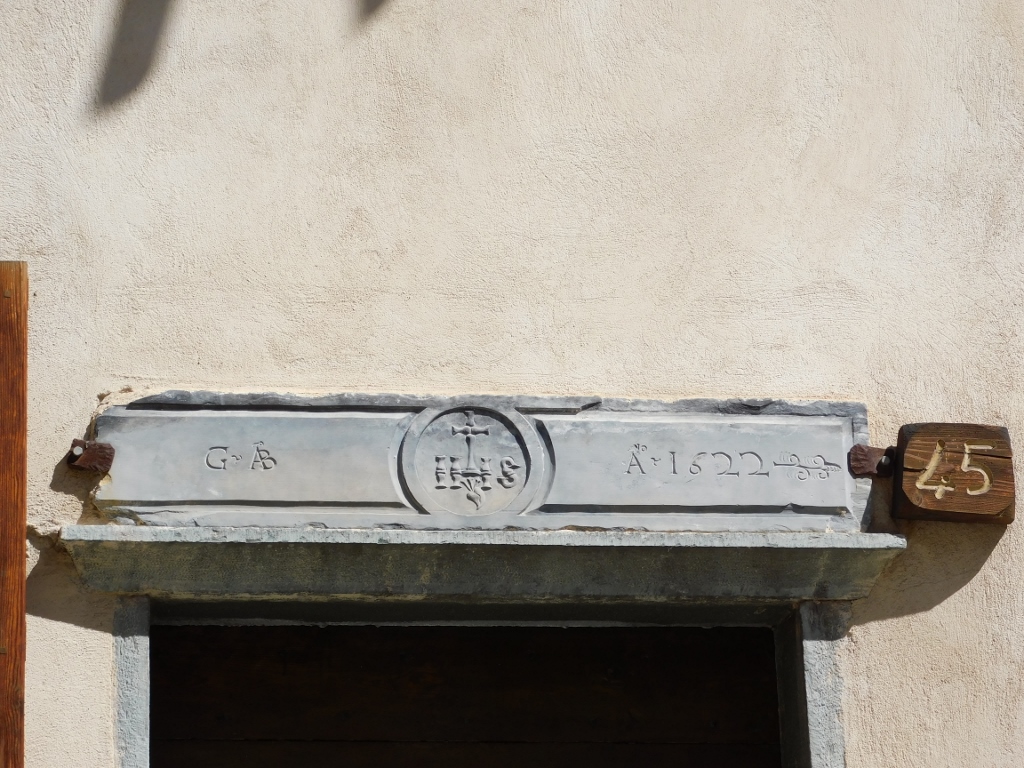 The 1622 lintel
The 1622 lintel
On the other side of the house there is a very picturesque “medieval” facade.
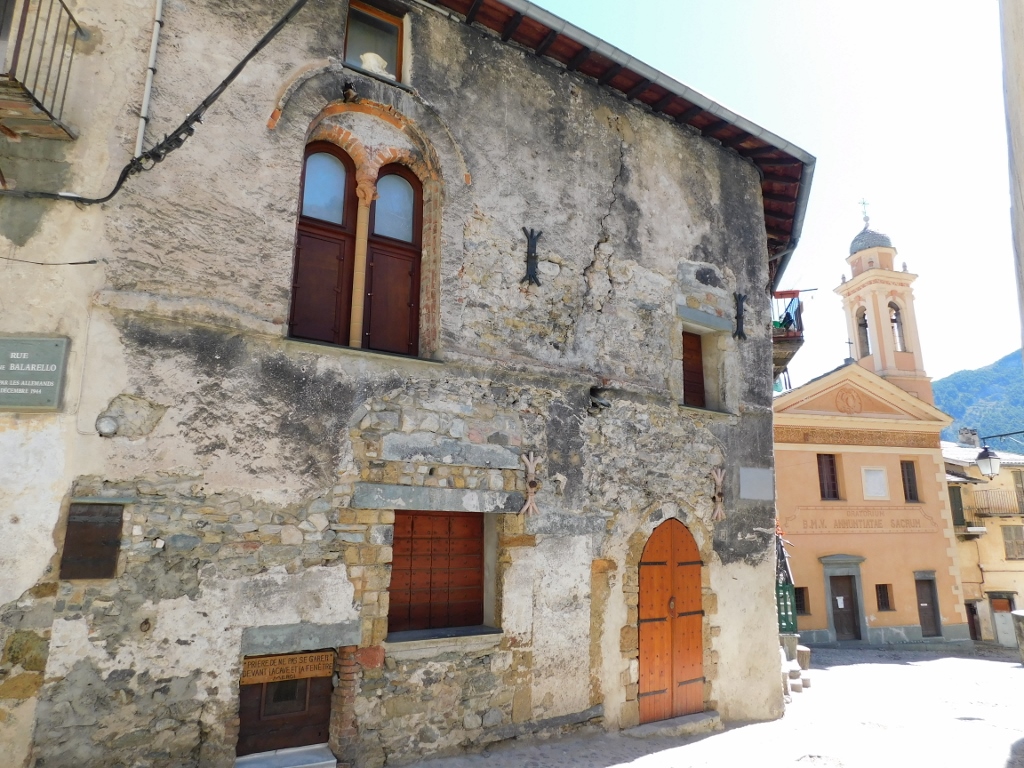 An old house in Rue Cotta with the Chapel of the White Penitents a little farther
An old house in Rue Cotta with the Chapel of the White Penitents a little farther
I particularly noted a sign at the opening towards the bottom of the facade wall: the owners ask people not to park their vehicles in front of their basement and its window.
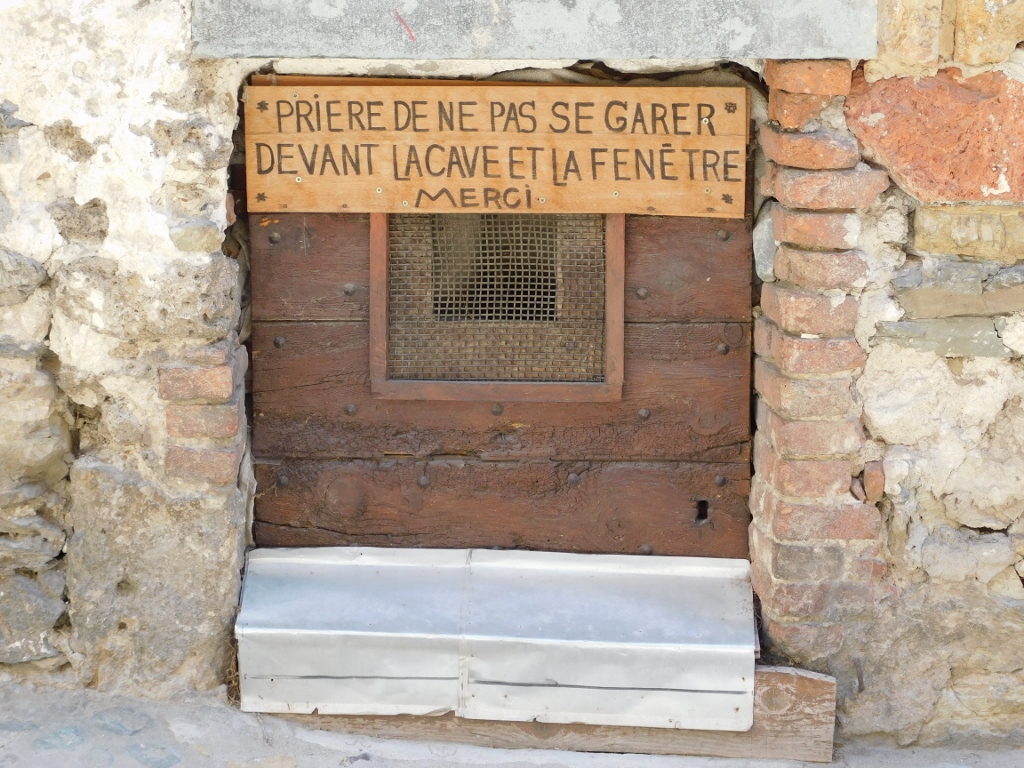 A detail from an old house in Rue Cotta
A detail from an old house in Rue Cotta
I also noticed a sign with the street name on the house. The street here has been named after Antoine Balarello killed by Germans in 1944. Tende may seem like a remote village somewhere in the Alps, but it has certainly gone through its dark hour, especially at the time of the large conflicts such as WWII.
From here I took yet another photo of the surroundings of Tende and they were still impressively beautiful.
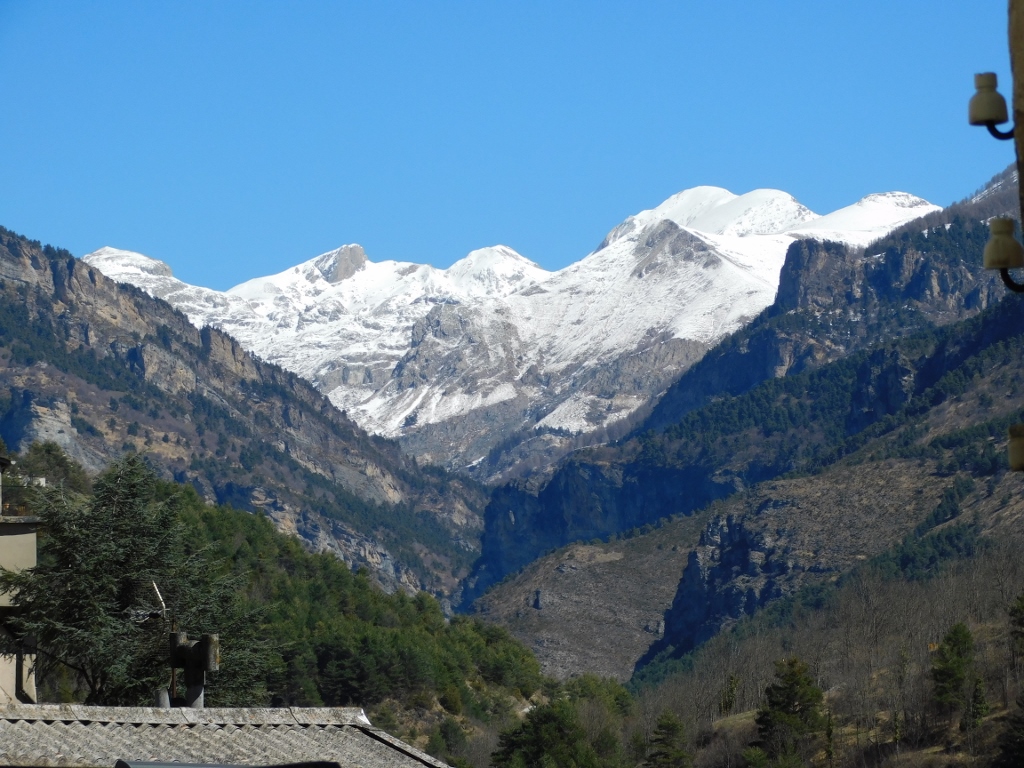 Surroundings of Tende
Surroundings of Tende
By now I started to return to the centre of the village and the main street, but on my way back I turned more into side streets. The sights were still very pretty and picturesque.
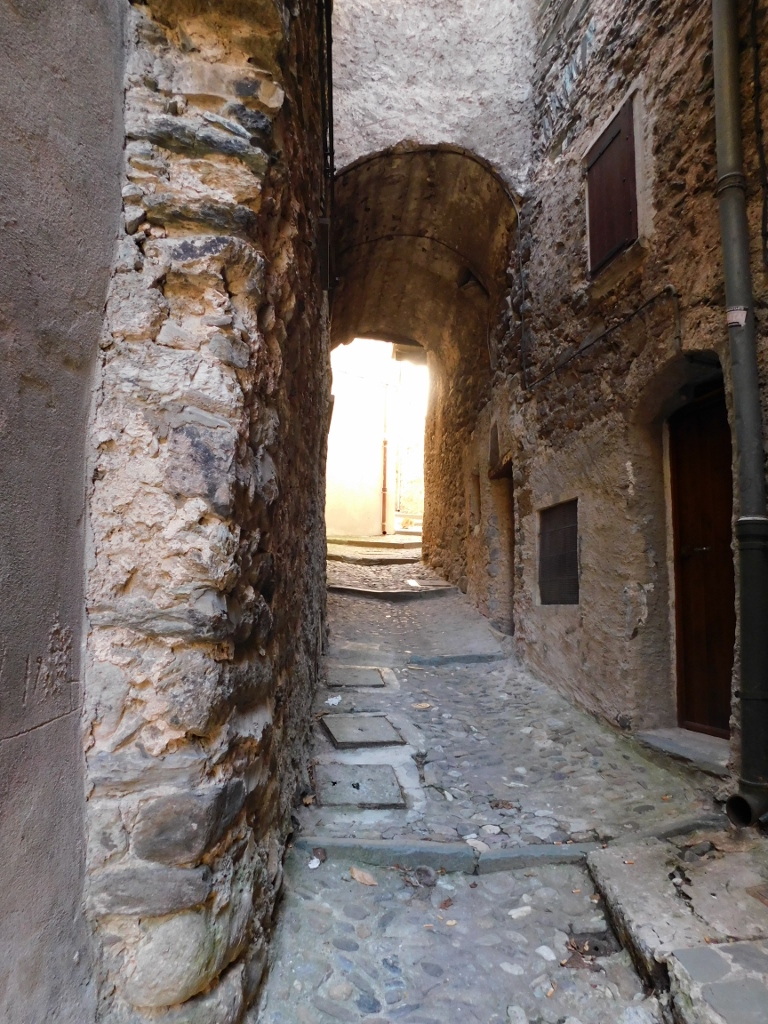 Tende, a detail
Tende, a detail
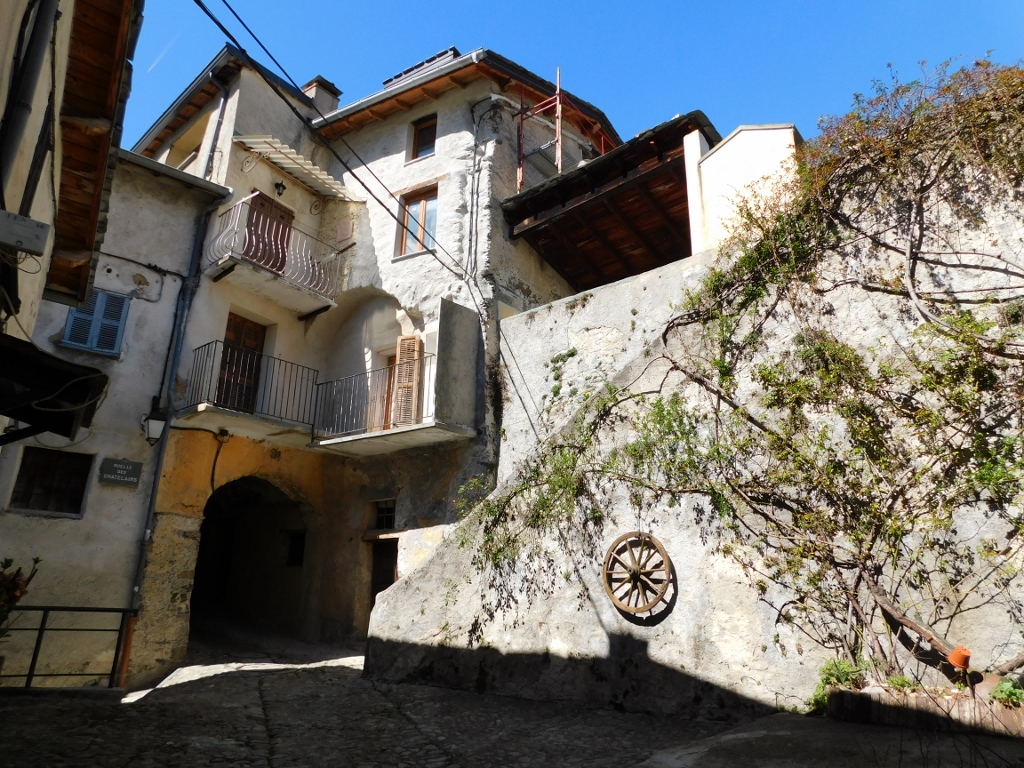 Tende, a detail
Tende, a detail
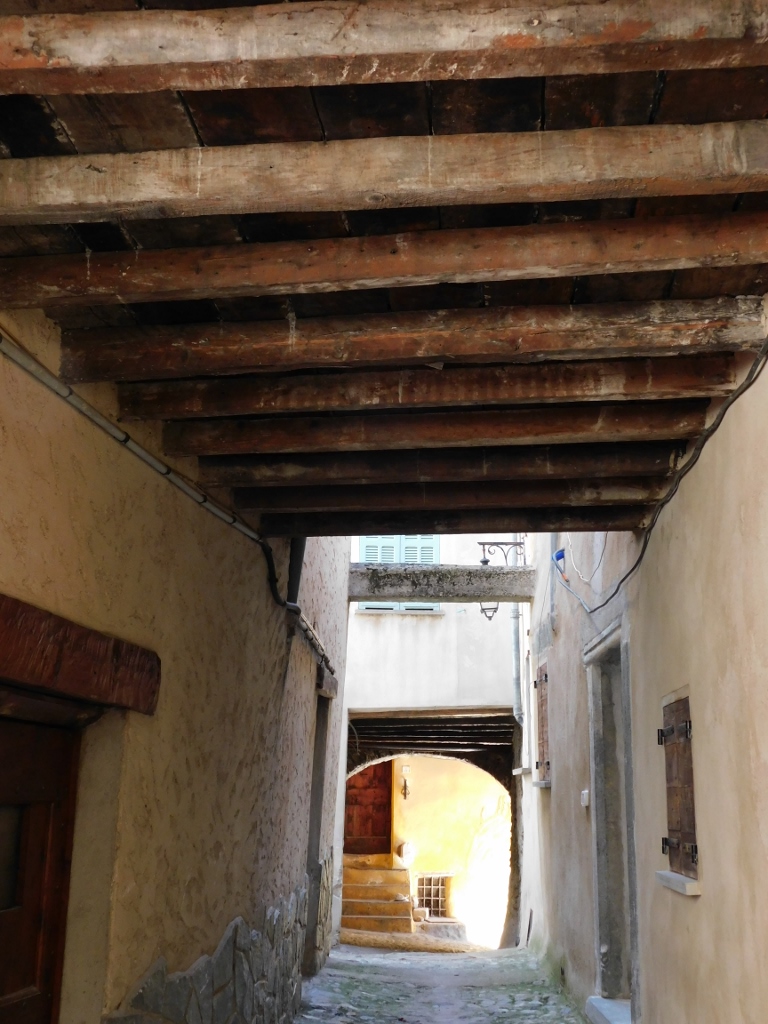 Tende, a detail
Tende, a detail
When I left the old parts of Tende, I found another nice viewpoint and from there I looked at other parts of village and the surroundings. From this point I could see well the railway bridge and another smaller one at its foot, for vehicles, that also spans the Roya river. This illustrates very well how the construction of a railway line in this landscape is a truly impressive enterprise.
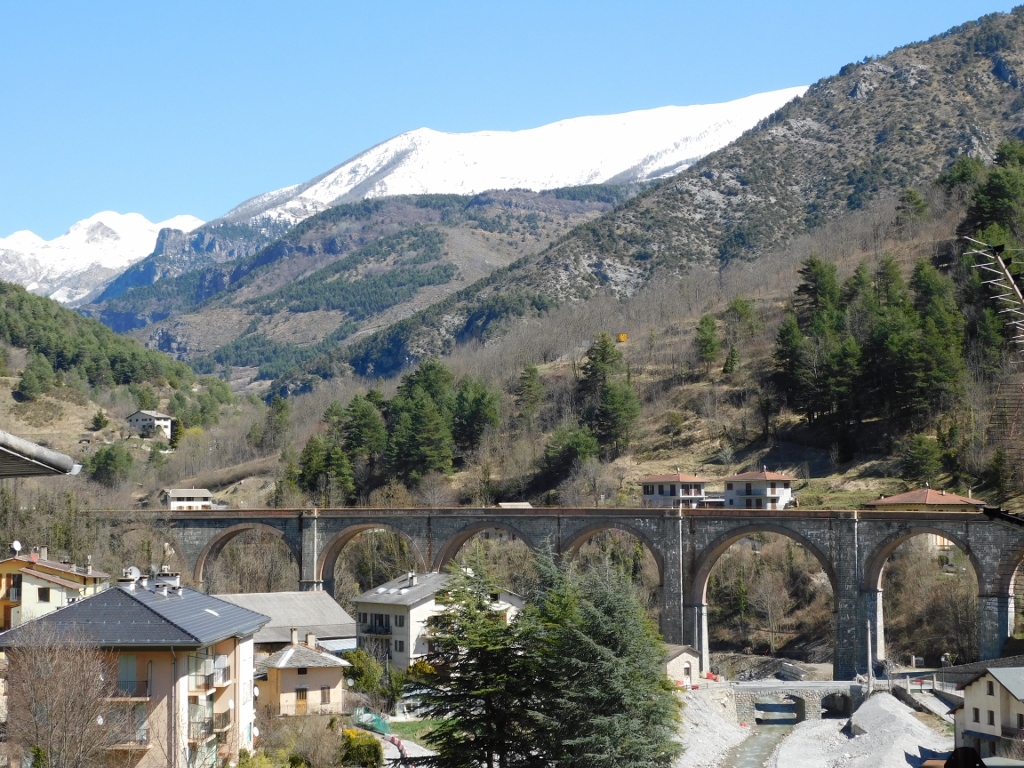 Tende and its surroundings
Tende and its surroundings
The day was gorgeous. There was not a speck of a cloud in the sky, there was no wind and even the temperature was not too low. Such weather conditions probably inspired others to enjoy the day, like I was, but in a somewhat different manner.
 Events above Tende
Events above Tende
As I’ve mentioned, I was thinking of perhaps going for a walk around the area. As I was told at the tourist office, there was a trail nearby that could be covered in 45 minutes and that seemed quite appealing, but... I was already a little hungry. With my experience of the previous day, when I was late for restaurants (opened during lunch time, but then closed until dinner time) and when I had to eat crisps and drink juice out of a bottle, I realised I would have to make a choice here: either go for a walk or go for lunch. I opted for the latter and so I went to a well-known local restaurant.
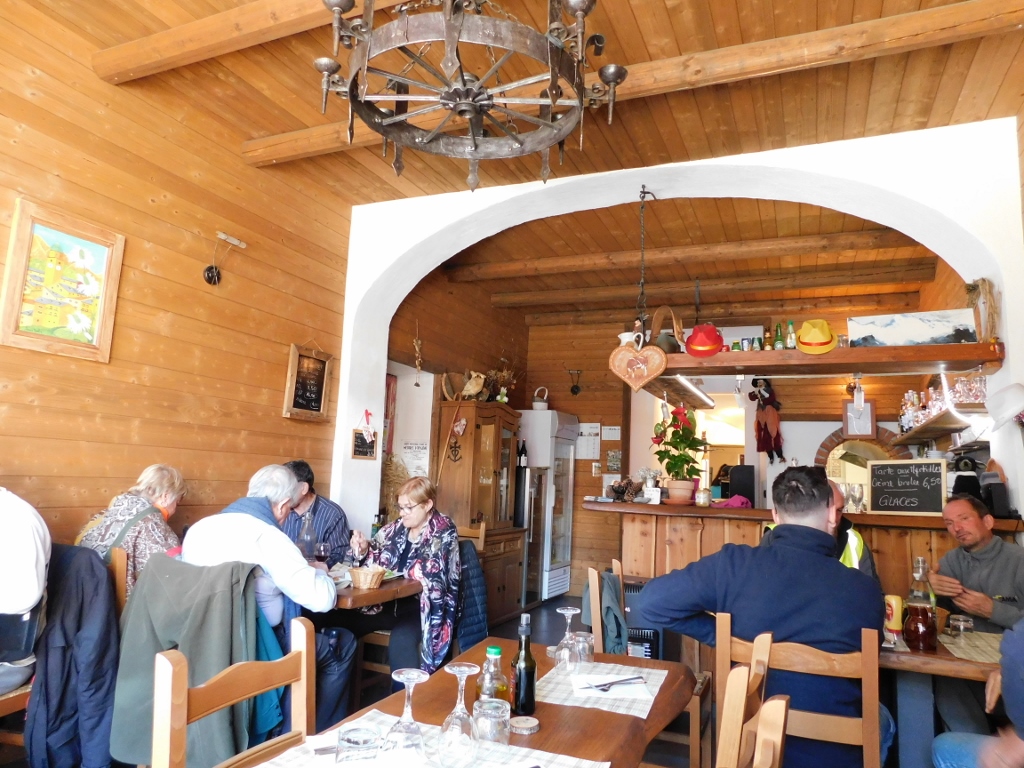 A restaurant in Tende
A restaurant in Tende
I selected one of the dishes offered in the daily menu and that was – rabbit. Many years ago I used to eat game every so often (the husband of my mom’s friend was a hunter and my mom was very good at preparing the game her friend supplied us with), but after that (the husband of my mom’s friend passed away), I did not eat rabbit meat any longer. That’s why I found this menu offer interesting. It was not bad, but I think my mom prepared it better.
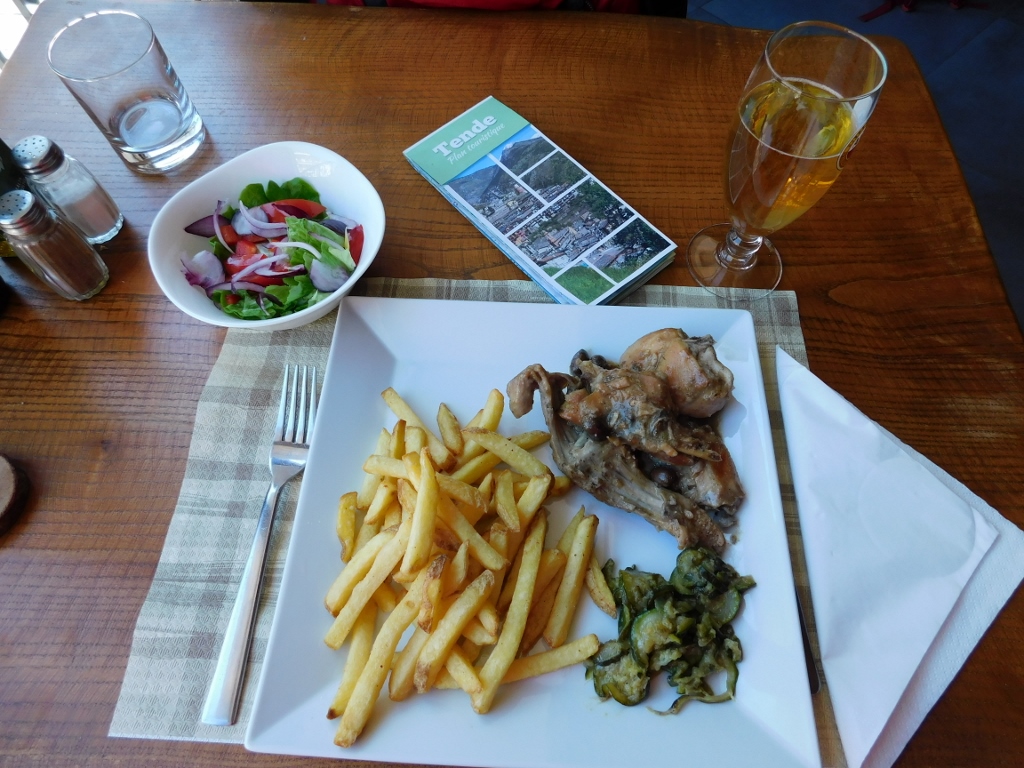 Lunch in Tende
Lunch in Tende
Although I was aware I would not have the time to go for a walk in nature, I thought there was no reason why I should not go at least to the beginning of the trail that was recommended. So, after the lunch, I went down to the Roya and the bridge that I had previously seen from the slope where the old part of Tende was. However, that bridge was closed on account of some maintenance work and even the pedestrians were not allowed to cross. That’s why I only took photos of the old part of Tende.
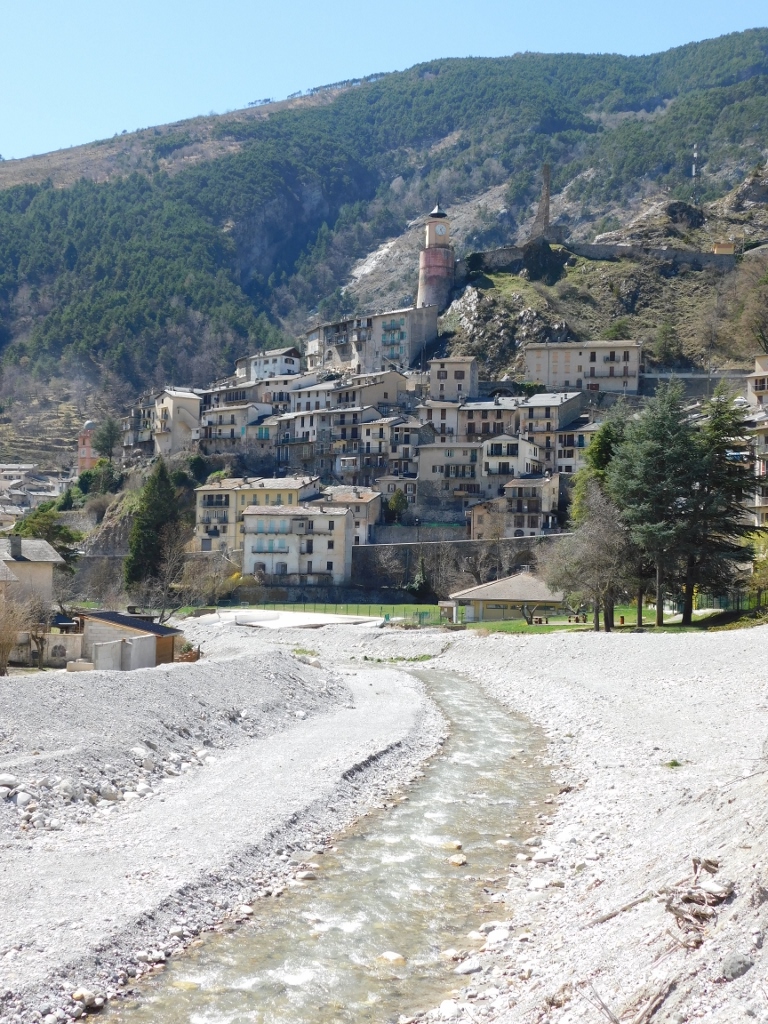 View at Tende from the bridge over the Roya
View at Tende from the bridge over the Roya
However, I did not return to the centre straight away, but following some side streets I got to an underpass for vehicles built underneath the railway tracks. As soon as I went through that tunnel, I noticed a path on the right-hand side and turned there.
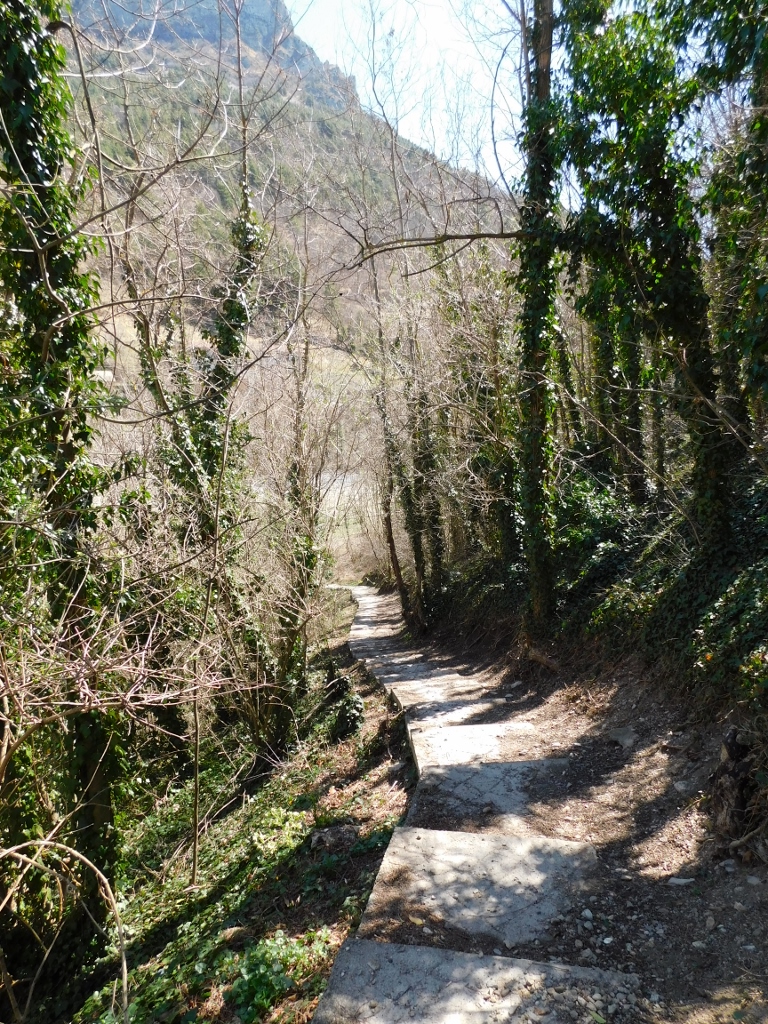 A path in Tende
A path in Tende
The path led through a grove in which I could hear different birds, but I could not take a photo of any of them. They simply moved around too much. But, I did come across some wonderful daffodils (narcissus), so I first remembered Wordsworth and one of his poems that I learned back in the high school, and then I took photos of them. They did not move at all.
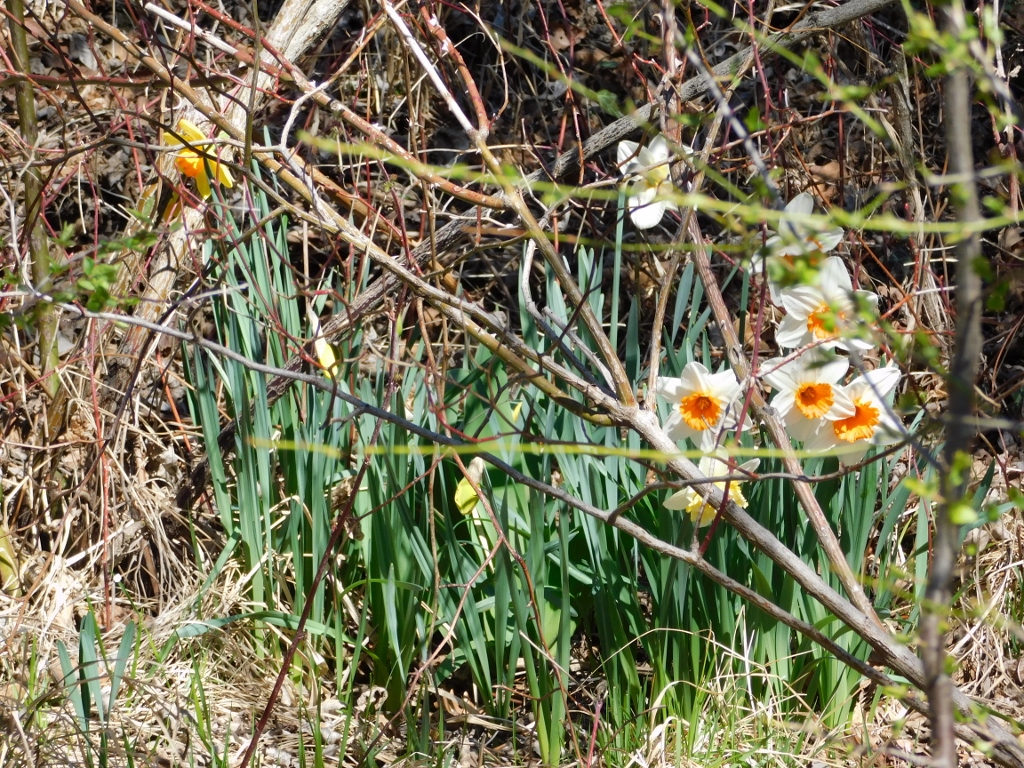 Daffodils
Daffodils
The path I followed, however, led only to a meadow, so I simply turned around and went back to the road where I continued walking in the direction leading out of Tende. Soon I crossed a bridge that was open to traffic and then I went down to the river.
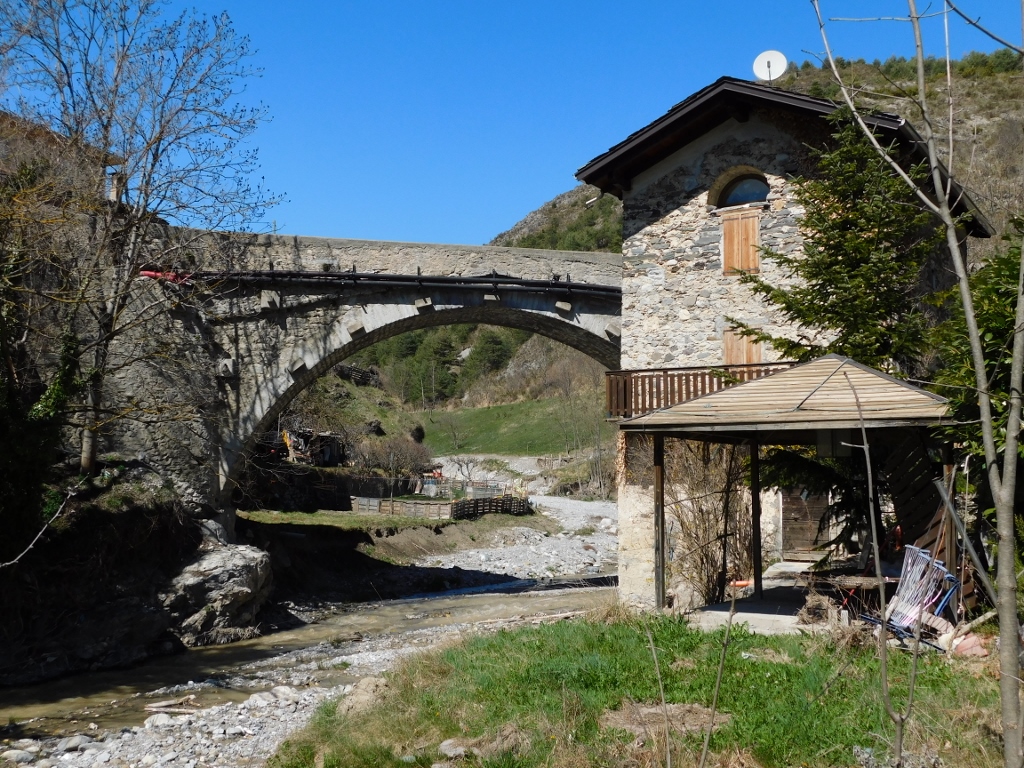 On the bank of the Roya
On the bank of the Roya
And yet, it was clear that there would be no walking in nature for me here, so I just went back to the centre of Tende. I still had a little time before the departure of the train and I found it more appealing to walk around than to merely sit at the station.
I walked again along the main street and beside a couple of interesting places. One of them is the Church of St. Michael (Eglise Saint-Michel) from the 15th century, while the other is the War Memorial (Monument aux Morts) dedicated to the residents of Tende who perished in the two world wars, as well as in the war in Algeria (1954-1962).
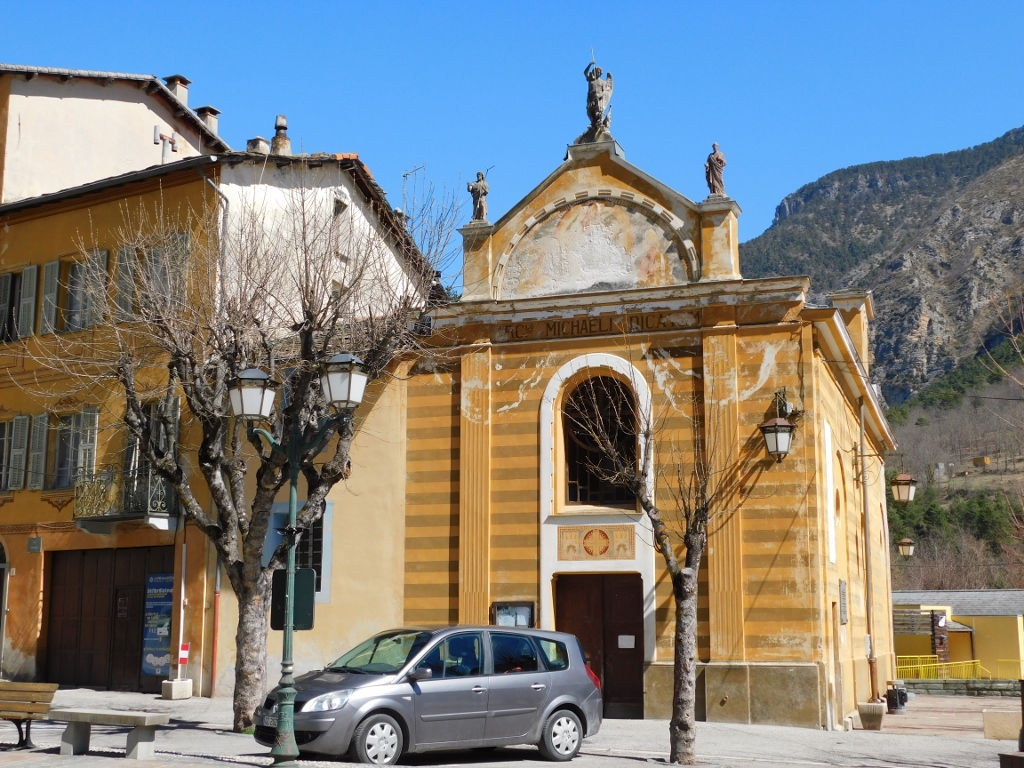 Church of St. Michael
Church of St. Michael
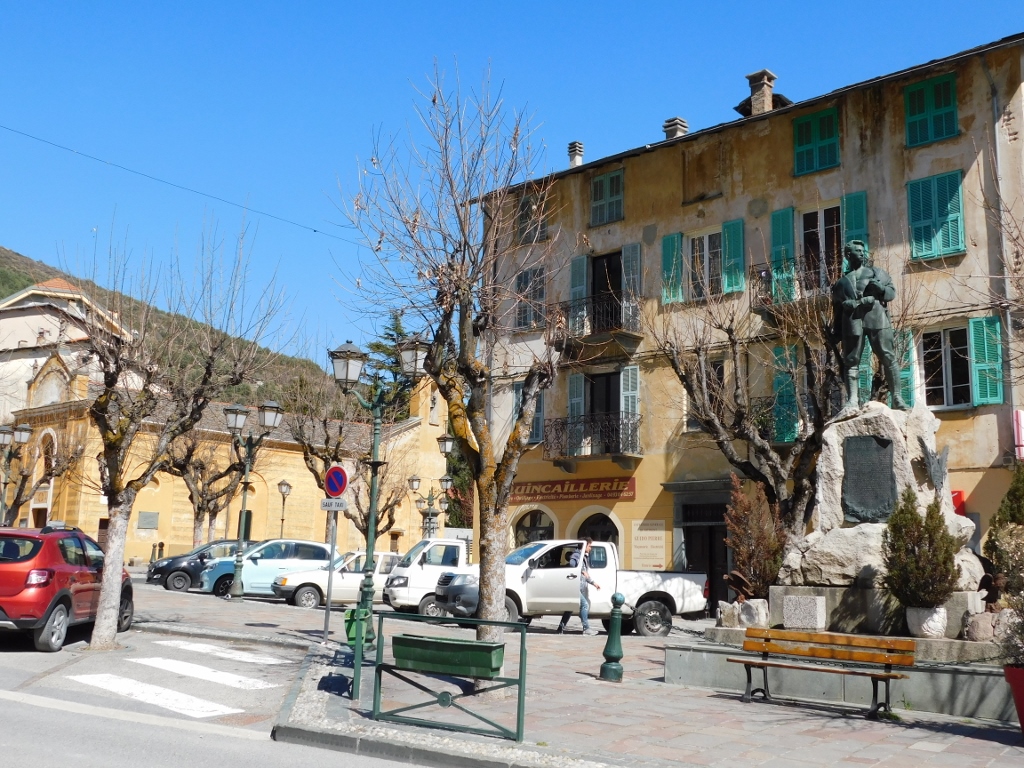 The War Memorial is in the right
The War Memorial is in the right
I still had the time to walk to the Museum of Marvels (Musée des Merveilles). I knew it was, unfortunately, closed on this day, but at least I took a photo of it.
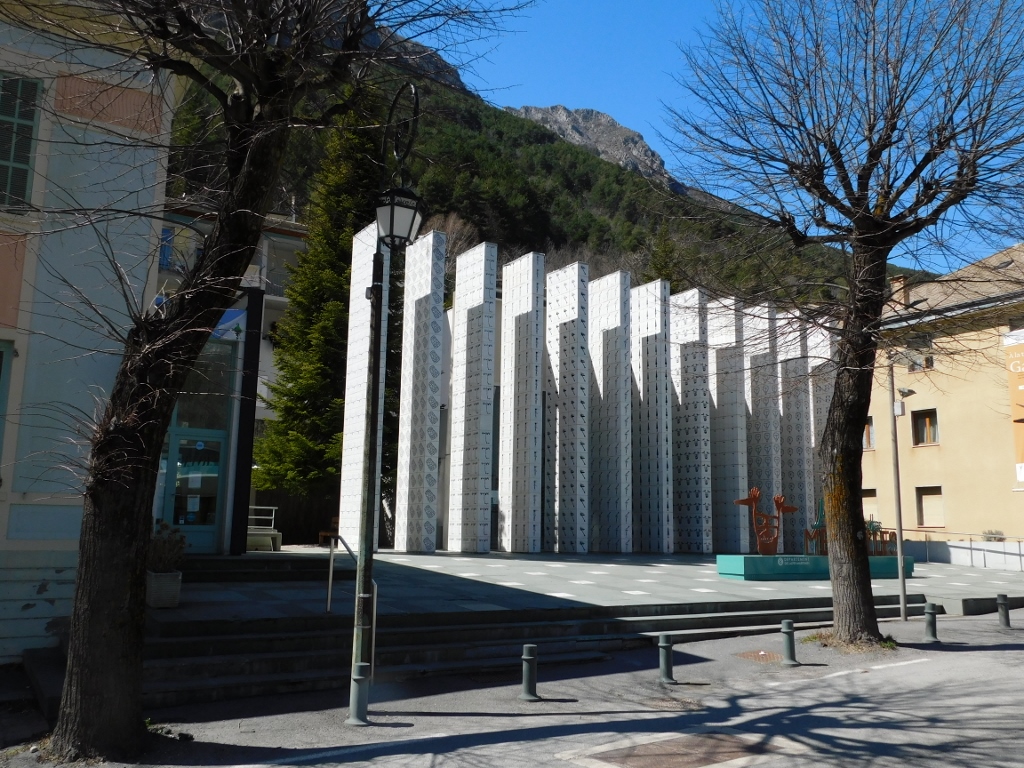 Musée des Merveilles
Musée des Merveilles
According to what I have read, the museum is very interesting since it contains a lot of exhibits linked to the Stone Age and the petroglyphs found on the territory of the Mercantour National Park. Some of the petroglyphs have been brought here, but a large number of them have been left in situ and so, for instance, in the Valley of Marvels (Vallée des Merveilles), some 20 km west of Tende, it is possible to see one of the largest quantities of petroglyphs from the Bronze Age in open air, at least in Europe.
Needless to say, I did not even think of going there now and I simply returned to the train station. Soon I started to head back in the direction of Nice, but with a plan to make a nice break along the way.